THE AUSTRALIAN


RRP $8.50 incGST
2024 Orienteering Australia acknowledges the Traditional Custodians of the lands where we conduct our sporting activities.We extend this acknowledgement to all the Traditional Custodians of the lands and First Nations Peoples throughout Australia, and would like to pay our respects to all Elders past, present and emerging. • Australian 3-Days 2024 • Orienteering Australia Honours & Awards • NOL races
JUNE


Sport Australia proudly supports Orienteering Australia
Sport Australia is the Australian Government agency that develops, supports and invests in sport at all levels in Australia.
Orienteering Australia has worked closely with Sport Australia to develop orienteering from community participation to high-level performance.
Orienteering Australia is one of many national sporting organisations that has formed a winning partnership with Sport Australia to develop its sport in Australia.
2 THE AUSTRALIAN ORIENTEER JUNE 2024
Cover: Liam Dufty at Australian 3-Days 2024. Photo by quentinjlang.com
www.sportaus.gov.au WINNING PARTNERSHIP
qentinjlang.com
Photo
by
The Chair’s column
MIKE DOWLING – CHAIR OA BOARD
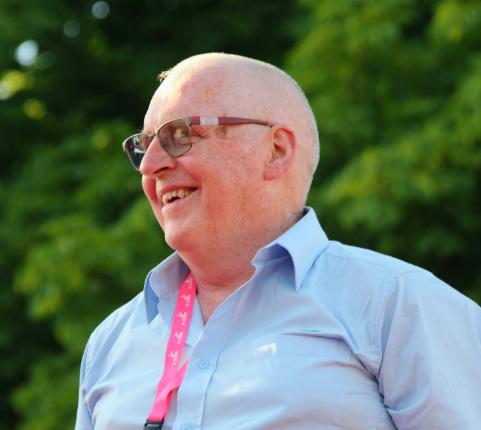
In the third week of April the Annual General Meeting of Orienteering Australia (OA) was held via the Zoom online application.The Board presented an overview of what it has undertaken through 2023 on behalf of our members and an overview of planned work for the forthcoming year.The audited financial statement was presented along with the budget for 2024. OA is running an operational deficit at the moment as it seeks to implement a range of strategic initiatives to grow engagement in participation in our sport. In addition, OA is now spending significant amounts of Australian Sports Commission Participation Growth Funding as it implements a range of initiatives this year. These include the implementation of a ‘Whole of Sport’ Orienteering Participation Plan, a national implementation of the Learn to Orienteer program and, after extensive consultation, implementing a range of improvements to our Eventor system for both end users and event organisers.
Brett Weihart, as the sole candidate for re-election, was elected and will continue to serve on the Board along with other Board members who were not up for re-election.Thus, your Board for 2024 is Clare Hawthorne (TAS), Andrea Harris (QLD), Anna Sheldon (QLD),Troy de Haas (VIC), Blair Trewin (VIC), Paul Liggins (TAS), Mike Dowling (TAS) and Brett Weihart (SA). Robert Spry (NSW) provides support as minutes secretary, and our General Manager Arpad Kocsik continues to manage operational business for the Board.
Over the coming months the Board will be implementing a range of recent policy decisions. One of these is a new Photography Policy that forms an important policy position for OA to implement our National Integrity Framework obligations, especially

Proudly supported by

around Safeguarding Children and Young People.The key aspect of this policy will be a more considered approach as to how OA, member states/territories and clubs publish photographs of people under the age of 18 through their official media channels. A guidance to the policy is being prepared by the Board. Interested readers may access the policy via the Operations Guide page on the OA website.
On the competition front we had a most successful Australian 3Days over the Easter period. Some of the days were very hot which can be an occurrence when Easter is in late March. On behalf of the Board, I extend a most sincere thank you to the organising team and all the volunteers who put in a huge effort to organise the event. Such events again demonstrate how much work volunteers do to ensure we can participate in our sport.
By the time you read this edition of The Australian Orienteer, the individual competition side of our National League will have concluded with the final rounds hosted by Orienteering Queensland and Orienteering ACT. Congratulations to the titleholders and a very big thank you to all the competitors and organisers of our premier domestic competition series.The teams competition for the National League will this year extend to the Australian Championships week. Our MTBO National Series is now well underway also. Major-event focus now turns to spring with our Australian Championships week carnival being held in the Northern Tablelands of NSW and our Australian Mountain Bike Orienteering Championships being held in the ACT. Both national championships promise to be great orienteering, and OA extends its thanks and appreciation to all the volunteers who are making a concerted effort to ensure their success.
Round 1 17-18 February HOBART, TAS 2 x sprint, middle
Round 2 29 March - 1 April EASTER THREE DAYS, SA sprint, middle, long & relay distance
Round 3 25-28 April BRISBANE, QLD 3x sprint (WRE, relay and knock-out)
Round 4 18-19 May ACT
NOLindividual final, middle distance & forest relay
Round 5 28 September6 October ARMIDALE, NSW
NOL team-only final (Aus Champs), middle, long, sprintdistance & relay
JUNE 2024 THE AUSTRALIAN ORIENTEER 3 ORIENTEERING AUSTRALIA
2024
Editor’s contemplations
Photography
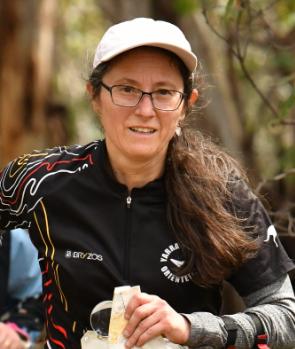
Orienteering Australia has adopted a photography policy. It applies to photographers and people they photograph at orienteering events, both children and adults. Parental permission is needed to take photos of under-18s, to publish their photos and to include their full names, the latter being the most relevant to major-award winners and Australian representatives. For adults, an efficacious practice may be to give people opportunities for communicating their reluctance to being photographed and / or to having their photos published with or without full names. Great pictures promote our sport but we also would like everyone feel welcomed, including those who for various reasons shouldn’t be photographed. If you don’t want your photo in The Australian Orienteer please send an email to magazine@orienteering.asn.au.
Photographs are very important as repositories of memories, for information, for marketing and for inducing emotional responses. They are essential for this magazine and other modes of orienteering communications, therefore I hope that we can streamline the process of obtaining permissions. Here are my suggestions.They may not be the best solution but we need something workable now, which can be refined with time.
National events may need a separate item on the Eventor, perhaps ‘Photographs of adults’ could be set up for adults to register that they don’t want photographs of themselves taken or published or identified.There could be extra boxes specifying what media people object to having their photos in.
For photos of children, event organisers could include a photography consent form on the Eventor with the registration for all classes up to MW18, and for minors in MW20 or 21, asking if parents give consent for photographing of their children by an Authorised Photographer, and for photo publishing.There could be a box requesting to see the photographs before they are published.
For other events, if organisers plan to take photos, perhaps they would need something at the registration on the day for people to write down their names if they don’t want their photos published. A form for consent to take photos of children would also be needed. Consent on Eventor would not capture those entering on the day.
Now, for some practical advice about photos.These days cameras in mobile phones capture photographs with high enough resolution for printing. However, care needs to be taken with settings (for print media, select the highest resolution) and with distribution (avoid compression of photos). Some applications condense photos for sending, so photos arrive pixelated. When reducing photos’ size for digital content, aim to have enough pixels for a sharp image. You may need to play with the software to find out the best settings.


4 THE AUSTRALIAN ORIENTEER JUNE 2024
Photo: quentinjlang.com
Original
JPEG reduced in Affinity Photo 2 from best quality 5063x2376px 13.7 MB to medium quality 1.2 MB. Easter Day 1. Photo by quentinjlang.com
HANIA LADA
cropped. JPEG. 5063 x 2376px, 13.7 MB, 43 x 20 cm 300dpi. Easter Day 1. Photo by quentinjlang.com

ORIENTEERING AUSTRALIA BOARD
Chair & Director – International (IOF)
Director – Finance
MikeDowling
PaulLiggins
Director – Technical AnnaSheldon
Director – IOF Foot O Commisioner
Director Coaching & High Performance
Director Media & Communications
Director – Ex Officio
BrettWeihart
ClareHawthorne
TroydeHaas
BlairTrewin
Director AndreaHarris
Secretary RobertSpry
ORIENTEERING AUSTRALIA STAFF AND OFFICERS
General Manager ÁrpádKocsik
Head Coach NatashaKey
Manager of High Performance & IOF Map Commissioner
Manager of Coaching Development
FredrikJohansson
BrodieNankervis
Participation Manager BrodieNankervis
Manager of Coaching & Officiating Administration JimMackay
National Sporting Schools Coordinator JimMackay
Chief Medical Officer MarkFreeman
Editor OA Enews LindaBurridge
Badge Scheme Secretary
Eventor Project Manager
Manager of Integrity and Complaints
MTBO Development Officer
STATE ASSOCIATIONS
JohnOliver
PaulPrudhoe
AndrewShipton
CraigSteffens
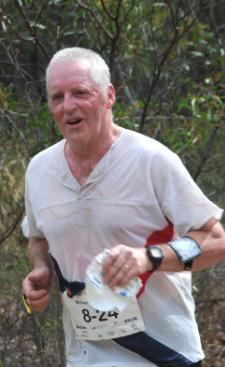



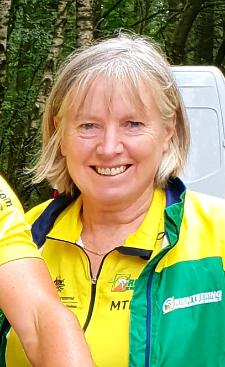

















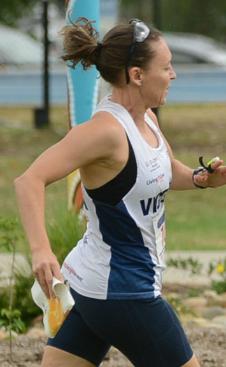

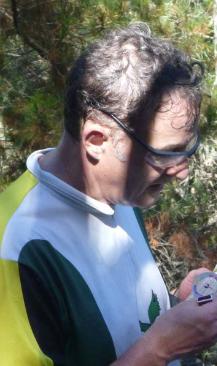

Orienteering Queensland: POBox275,FernyHillsDC,QLD4055.Secretary:SueCampbell secretary@oq.asn.au Orienteering NSW: POBox3379NorthStrathfieldNSW2137.Secretary:GayleQuantock secretary@onsw.asn.au Orienteering ACT: POBox402JamisonCentreACT2614.Secretary:StephenGoggs office@act.orienteering.asn.au Orienteering Victoria: POBox1010TemplestoweVIC3106.Secretary:AislinnPrendergast secretary@vicorienteering.asn.au Orienteering SA: 1 Windsor Rd, Glenside SA 5065. Secretary: Fi Pahor secretary@sa.orienteering.asn.au Orienteering Western Australia: POBox234SubiacoWA6904.Secretary:CeriPass oawa.secretary@gmail.com Orienteering Tasmania: Secretary:KlaasHartmann secretary@tasorienteering.asn.au Top End Orienteers (Northern Territory): POBox39152WinnellieNT0821.Secretary:SusanneCasanova
THEAUSTRALIAN
ISSN 0818-6510 Issue 2/24 (no. 213) JUNE 2024
The national magazine of Orienteering Australia Inc. ABN 77 406 995 497 Published four times a year: 1 March, June, September, December. Copies are dispatched in bulk to state associations in the week prior to that date. Print Post Approved PP 236080/00011, (100023602 for NSW).
Editor: Hania Lada, P.O. Box 200, Ringwood East, Victoria 3135 magazine@orienteering.asn.au Phone 0493 615 203 Magazine Design & Assembly: Peter Cusworth, Phone 0409 797 023 pcusworth53@gmail.com
Printer: Razer Graphix, Factory 6/15 Stud Road, Bayswater. Contributions welcome! Prior consultation is suggested before preparing major contributions. Guidelines available from the editor and the website https://orienteering.asn.au/index.php/magazine/ Orienteering Australia website > magazine
Regular Contributors: History & Awards – David Hogg; Competition –Blair Trewin
Subscriptions: State Association members via State Associations. Contact relevant Association Secretary for details. Other subscribers: For information about payment refer to the Orienteering Australia website https://orienteering.asn.au/index.php/magazine/ Orienteering Australia website > magazine or contact the editor.
Opinions expressed in The Australian Orienteer are not necessarily those of Orienteering Australia.



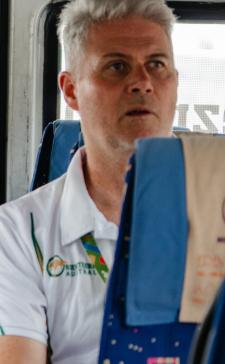

JUNE 2024 THE AUSTRALIAN ORIENTEER 5
www.orienteering.asn.au PO Box
CONTENTS THE CHAIR’S COLUMN ...............................3 EDITOR’S CONTEMPLATIONS ........................4 AUSTRALIAN 3-DAYS .................................6 O’SHEA 2 DAYS ......................................13 NOL REPORT ..........................................14 ORIENTEERING IN NZ ...............................16 JUNIOR COURSE-SETTING .........................18 CLANDULLA 2009 AND 2024 ......................24 MOIRA WHITESIDE O BEQUEST ..................26 PARTICIPATION ......................................27 I CAN DO THIS! .....................................28 MTBO TRAINING CAMP ............................32 BEST ORIENTEER ....................................34 HIGH PERFORMANCE NEWS .......................38 AUSTRALIAN ORIENTEERING WEBSITES .......40 ORIENTEERING AUSTRALIA AWARDS ...........42 O-SPY ..................................................46 TOP EVENTS ..........................................47
topendorienteersNT@gmail.com
3379, North Strathfield, NSW 2137
John Oliver**
Anna Sheldon
Andrea Harris3.
Fredrik Johansson
Clare Hawthorne
Paul Liggins
Blair Trewin
Mark Freeman*
Paul Prudhoe Árpád Kocsik
Natasha Key*
Jim Mackay2.
Mike Dowling4 Brodie Nankervis*
NEXT ISSUE DEADLINE July 19. Time-sensitive: July 26.
quentinjlang.com except
website, 2.OA website, 3.anon, 4.AO 2021-4.
Brett Weihart1.
Photos by
*by Tony Hill, **Kath Oliver, 1.JWOC2023
2024 Australian 3-Days
TREWIN REPORT
The Australian 3-Days this year came to South Australia, marking 50 years since the competition was first held in 1974.The bush events were on a trio of maps on the eastern edge of the Adelaide Hills, familiar to South Australians to a greater or lesser extent but less so to most of the rest of the Australian orienteering community.The first two days featured areas of low-visibility shrubland and small rock detail with large open areas in between, the third had more of the low-visibility terrain and tripped many up at the final hurdle. It was an early Easter and featured the last serious hot weather of the season, which added a level of difficulty, particularly on the long second day. As usual, proceedings got under way with the prologue on Good Friday, this year at Heathfield on a map which combined a school with some nearby bush. Although it no longer counts as part of the overall result, as a selection trial for both WOC and JWOC the stakes were still high. In what has become a familiar story in the last year or two, the leading junior women outperformed their senior counterparts, with Milla Key and Nea Shingler doing the two fastest times of the day (although Caitlin Young would have gone close to matching them without a first-control mispunch). Key led all the way, with a 20-s mistake by Shingler at #18 turning a close race into a comfortable one.





6 THE AUSTRALIAN ORIENTEER JUNE 2024 EASTER 2024
Kelvin Meng.
Sprint photos by Evalin Brautigam, website
evalinmae.smugmug.com
Grace Crane. Kirsten Fairfax.
Keely Williams and Michael Westover approaching the last control.


In the senior race, Rachel Snell (formerly Effeney), returning to elite competition after giving birth last year, led early on, but Grace Crane took the lead entering the bush section mid-race and kept it thereafter, with Mikayla Cooper emerging at the head of a close bunch in second.



Aston Key and Angus Haines both made promising starts in the men’s race, but Key – continuing to suffer from longterm injury issues – withdrew, and Haines lost significant time on #18 to drop out of contention. From there Brodie Nankervis led for most of the lead, although Ewan Shingler and the South Australian pair of Ethan Penck and Leith Soden were in the mix at times.The lead got out to 21 s at #21; Shingler pulled a little back, but not enough. In the junior event, Sam Woolford, Callum White and Cooper Horley swapped the lead through the first half before Woolford took control, withstanding a late surge from White.
Grace Crane’s sprint win might have been slightly unexpected but her flagto-flag win over the three bush days was less so. She was already on top after the middle distance on the first day after opening up a 2-min gap on Aislinn Prendergast and 4 min on the rest of the field, but it was the long distance, her best event in recent times, where she really took control.There she was 5min ahead of Emily Sorensen after a dominant performance. Sorensen in turn set up her eventual second place by being 10 min ahead of everyone else, as many dropped away on the last third of the course on a hot day (in the

JUNE 2024 THE AUSTRALIAN ORIENTEER 7
Nea Shingler.
Rob Preston.
Monika Lee and Jo Hobson.
Kathryn Preston and Rachel Snell.

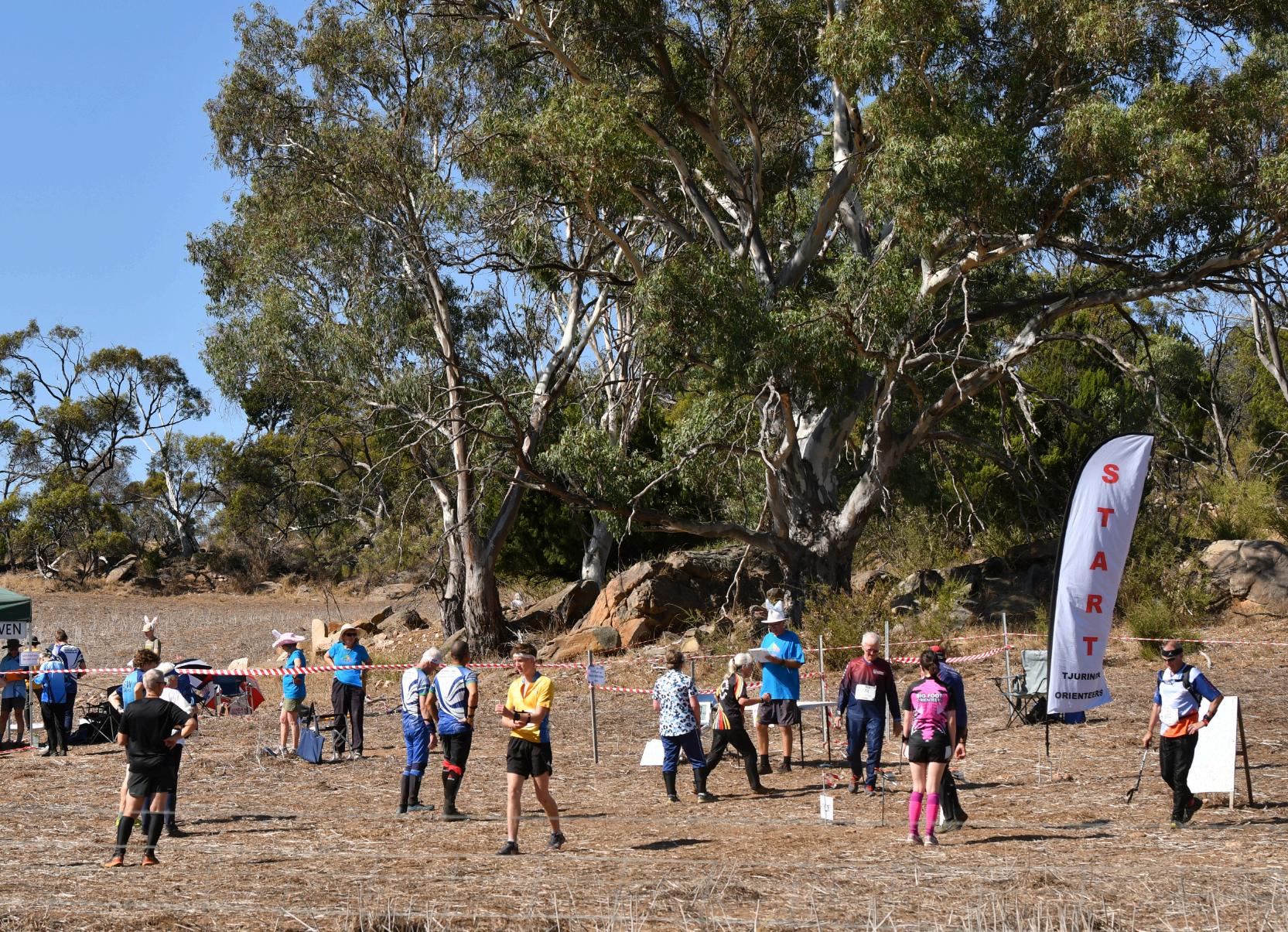





first year when the women and men have had equal winning times). The third day was the most interesting of the three in its own right, although the many fluctuations had little bearing on the overall result; Crane, after a slow start, was still fifth on the day with four controls to go, but multiple errors over the closing stages – Caitlin Young’s six-minuter at the third-last when leading being the most significant – gave her the chance to make it a clean sweep. Sorensen was second overall, 12 min back, with Vanessa Round completing the placings.
The first, middle-distance, day in M21E was a tight contest, with Alastair George pipping Brodie Nankervis by 4 s, and Leith Soden and Ewan Shingler also within a minute. George made a slow start and was still seventh at #6, but built into the race and had got to the lead by the last few controls. He, Nankervis and Soden swapped 30-s mistakes in the last few controls with the Big Foot runner just emerging in front.Those opening contests were interesting but, as is often the way, the long day was decisive, and it was here that George fully took charge, opening up a 5-min gap on his
Tasmanian rival on a day when the margin got bigger as the course went on. He then completed a clean sweep on the final day, losing some time early (as did Nankervis) but getting to the front after early leaders Ewan Shingler and David Stocks struck trouble in mid-course, and ultimately extending his lead to 8 min with Nankervis second. Soden had been third after two days in his first major competition as a senior, but was unable to match that performance on the last day, with Shingler (in his second senior year) overtaking him for third.The result was a significant step up for George, who had been consistent through his early senior years without breaking through for any big wins.
The two senior elite classes might have both seen the same winner on all three days but it was a different story in W20E, where eventual overall winner Nea Shingler did not win any individual days (one of two overall winners to do this, along with Craig Dufty in M50A). Both the first two days were close, with 22 s covering Milla Key, Shingler and Natalie Miller on the opening day, and a bit over 3 min covering a top five led by Erika Enderby on the
8 THE AUSTRALIAN ORIENTEER JUNE 2024
EASTER 2024
Day 1 start. Photo by quentinjlang.com
Day 2. Zoe Scott.
Photo by quentinjlang.com
Day 1. Bert Elson. Photo by Sputnik theawesomest.com
Day 2. Zoe Carter.
Photo by quentinjlang.com



2024 marked 50 years of the Australian 3-Days. There were five competitors in the 2024 event who were also there in 1974: John Oliver (the winner of M21E in 1974), Alex and Janet Tarr, Steve Flick and Carl Dalheim. None of them managed to be on the podium 50 years apart, although two got close – John Oliver was fifth in M75A in 2024, while Alex Tarr, the M80A winner this year, was fifth in M21E in 1974.
Attendees at 1974 and 2024 Australian 3-Days, and David Hogg who reminded all about the 50-year anniversary.
Photo by Sputnik. theawesomest.com
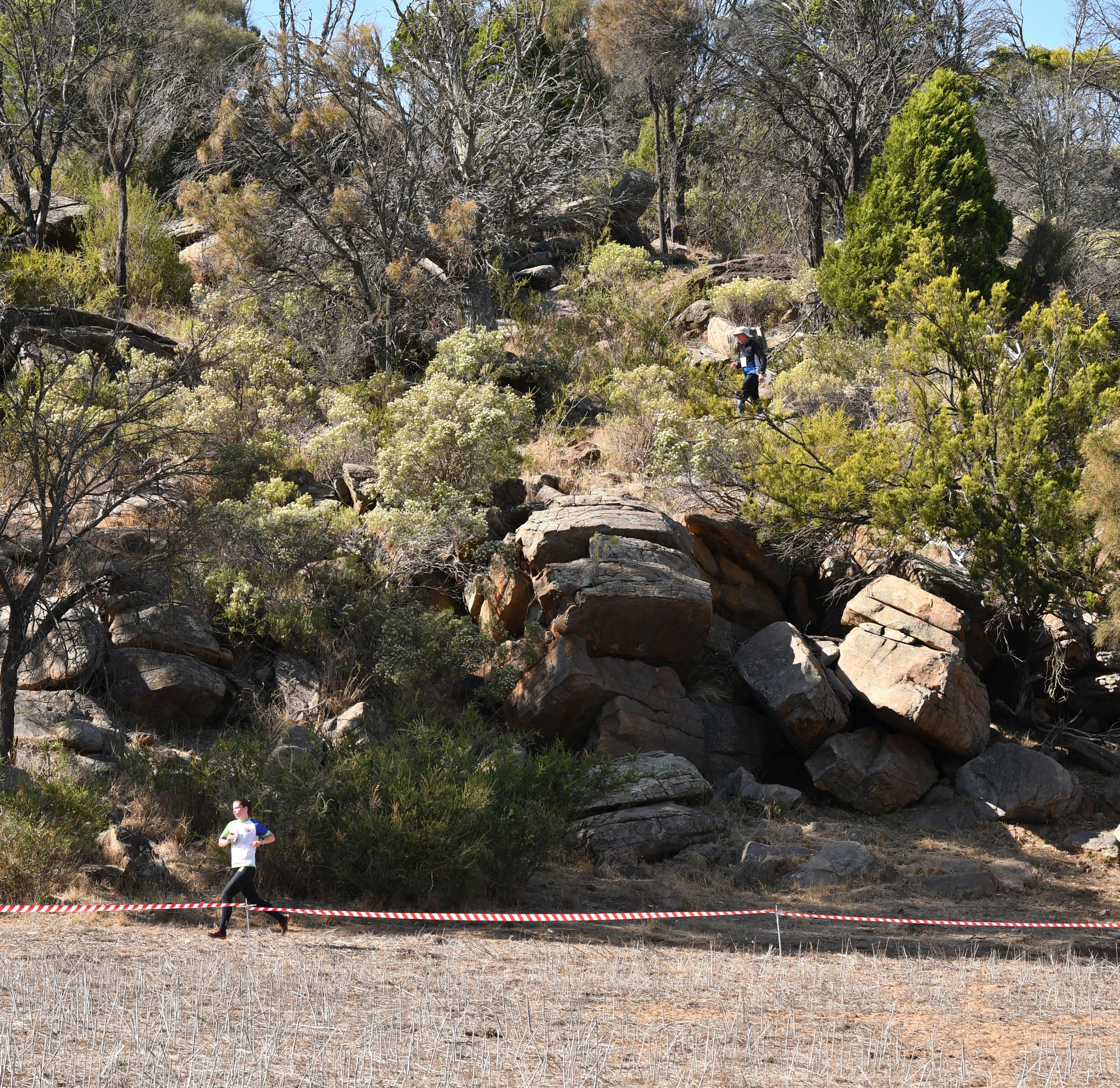
second. At that stage Key was in the overall lead with Shingler, Miller and Enderby all within 4 min, but things were turned upside down when she lost 8 min at the first control on the last day (and another three at #2), ultimately dropping her to sixth. Shingler also lost some time on #2 (as did many others), but was consistent thereafter on a day when many were not, and did enough to claim overall honours by 3 min from Miller. Zoe Carter’s last-day win, jumping from third to first at the third-last control, saw her advance to the podium.
Sam Woolford was a comfortable winner in M20E, taking all three days and winning overall by 12 min; others challenged him on each of the three days but none could do so across the whole weekend. On the first and third days his nearest rival was his brother Jamie, but in the end the decisive part of the battle for second overall was Callum White’s strong second half on the long day, climbing from fifth to second there and maintaining it on the last day despite some wobbles. Oskar Mella was also well in contention for second after two days but lost time at the first control on the last day,


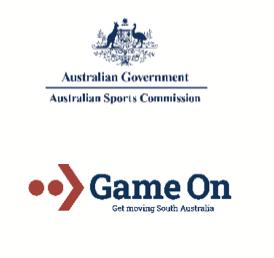

placing him into a tight battle for third with Jamie Woolford in which Woolford ultimately prevailed by 58 s.
The two closest classes of the event were W55A and M75A, both decided by 10 s. Jenny Enderby’s absence through injury made W55A an open race, and it was Cath Chalmers, coming back from a significant injury of her own, who emerged in front, closing a 9‐min gap to Wendy Read over the first few controls of the last day, and then holding on after almost blowing it on the last leg. In M75A Steve Flick led a group of four covered by less than 3 min. He set the result up with a win on the first day, but then had to come from behind after losing significant time at the first control on the last, and did not regain the lead over Paul Hoopmann until the last control. Major time losses on the first day by Hoopmann and Tony Radford (who was fourth) proved crucial to the overall result.
W75A was almost as close – the eventual winning margin was 1:07, and all but one of the finishers were within 14 min – and saw huge fluctuations. Pat Miethke came from 16 min down and fifth place
JUNE 2024 THE AUSTRALIAN ORIENTEER 9





after two days to the lead after three, after second-day leader Libby Meeking struck trouble twice in the second half of the final day. The other class with a margin under 2 min was the oldest, M85A, where Barry Hanlon edged out John Hodsdon by a minute.
The technical final-day terrain had plenty of scope for big changes at the end, and two other classes saw winners overtake the secondday leaders on the last day, with Katie Clauson coming from 6 min down in W16A and Sue Key from 4 min down in W70A. Louise Fairfax, returning to regular competition in the last year after a lengthy absence, led after two days but dropped to third as Key won the last day by 13 min, while Clauson’s consistent finish saw her overtake her younger sister Ella, as well as Ariadna Iskhakova. In M50A and M55A the second-day leaders fell by the wayside altogether. Steve Craig opened up a narrow lead over Eric Morris on the first day, which stayed unchanged as they dead-heated on the second day, but a leg injury forced him out at that point leaving Morris with an easy victory. In M50A the drama happened even later; Grant Bluett won the first two days, took a 10-min lead into the last day and then mispunched at the fourth-last, leaving Craig Dufty to emerge at the front of one of the event’s deeper fields.

There were also plenty of dominant performances, with 14 A and E classes having the same winner on all three days (an unusually large number). No-one was particularly surprised to see clean sweeps by the likes of Matt Crane in M40A, Natasha Key in W50A or Alex Tarr in M80A, all of whom were about a half-hour ahead of their nearest rivals. A little more unexpected was a similarly large Ted van Geldermalsen’s margin in the usually competitive M70A, a result which owed a lot to consistency as his largest lead on any individual day was a bit over 4 min. Rohan Braid was an even bigger winner in M14A with a 42-min gap on the field (in which the next five were then covered by 4 min), while Debbie Davey and Eoin Rothery also got three out of three in W65A and M65A, respectively.
Many of the elite and junior competitors will be moving onto international events in the northern summer, following the final two National League rounds in late April and May. For the rest, the next major national competition will be the Australian Championships in Armidale at the end of September.The 3-Days enters its second half-century in Victoria next year.
10 THE AUSTRALIAN ORIENTEER JUNE 2024
EASTER 2024
Day 1. Five orienteers emerging from the rocky woodland. Photo by quentinjlang.com
Sledge competitors using up some eneregy. Photo by Sputnik theawesomest.com
Ken Post. Photo by quentinjlang.com
Day 2. Barbara Junghans. Photo by quentinjlang.com














JUNE 2024 THE AUSTRALIAN ORIENTEER 11
Day 3. Andrew Slattery. Photo by quentinjlang.com
Day 3. Sam Woolford sprinting to the finish of day3, followed by Ella Clauson and Ella Maja Lang. Photo by quentinjlang.com
Day 3 Happy finishers. Aus 3-Days top 5 in elite women. Clockwise, Mikayla Cooper (4), Julia Gannon (5), Vanessa Round(3) and Emily Sorensen (2). Photo by Sputnik theawesomest.com
Zoe Carter’s route, fastest in W20E











BOOK
SOON

Remember to book accommodation soon, it’s a busy time of year in Central Victoria and accommodation is already filling up.
In 2025 ANZAC Day falls on the Friday just after Easter, giving the opportunity for more orienteering. The local orienteering clubs will be o ering events on new maps in Loddon Shire and close by, including a new area adjacent to Kooyoora. So consider staying on for this second weekend and taking in some tourist activities and training between events.



12 THE AUSTRALIAN ORIENTEER JUNE 2024 17km 52km 23km BORUNG DAY 2 INGLEWOOD TO BENDIGO MELBOURNE WEDDERBURN DAY 1 TARNAGULLA PROLOGUE DAY 3 29km Enjoya aus3days2025.orienteering.asn.au aus3days2025.orienteering.asn.au
Enjoyableareas,enjoyablemaps, enjoy a ble courses Prologue - Mining Day 1 - Gold mining Day 2 - Granite Day 3 - Spur-gully Get your orders in for 2024, latest shipment has arrived https://goo.gl/t81zFf pretex Jim Russell Ph. 0411 125 178 jymbois@gmail.com Advertise You can have a 6 x 9 cm colour advert for just $50 Send artwork to the editor: magazine@orienteering.asn.au

O’Shea 2 Day 2024 (NSW Central Coast)

History
The O’Shea 2 Day started just over 40 years ago. It was originally called the ‘Toukley 2 Day’. Frank Anderson and family started this tradition using various formats he had experienced while at European events. Frank was also the instigator of the very popular ‘XMAS 5 Days’ with both events continuing to this day. Back then it was just Frank and Ethel setting, controlling, organising, printing maps (manually) and doing all the on-the-day stuff at both the Toukley 2 Day and Xmas 5 Days, with just some help in collecting controls.
O’Shea 2 Day 2024
Held on Rumbulara Mountain, just behind Gosford, a notoriously steep area but a great location close to Sydney, offering some navigational challenges. The event is a simple teams’ event consisting of three races over a 22-h period. Each team member runs their own races achieving an individual time but this accumulates for a team effort. Teams can choose to run as a ‘long team’ or a ‘short team’ then the team can select a long-course runner and a short-course runner. Keep up, it is not that confusing! You have a ‘long team’ consisting of a longcourse runner and a short-course runner. Same for the ‘short teams’. But we only set three courses, a LONG, a MEDIUM and a SHORT.
Still got you? Or confused? I am! You should be there on the day trying to organise everyone. GREAT FUN! So the ‘long teams’ have a long-course runner and a medium-course runner, while the ‘short teams’ have a medium-course runner and a short-course runner.
Saturday afternoon we set a bush-relay event with two mass starts to split the long and short teams. Saturday night had a line course which was set in a more suburban area (East Gosford) giving a mix of street and park navigation under headlamps. Map flips and different scales, under lights, sent out at 1-min intervals.
Sunday was back on to Rumbulara for a team ‘score’ event with each team having to split the control collection and arrive back at the last control where they have to wait for their team member before finishing together.
This is a great and fun event with prizes (the traditional tree cakes) attracting many family teams, and there are no age groups, which creates course-planning challenges to set only three courses. This year we had competitors of age 6 years (some shadowing allowed) up to over 75 years.
We also had a group of elite orienteers grace the event as they knew the area offered good training opportunities close to Sydney. Not necessarily a great navigational challenge for them due to there being only three courses but a solid workout and some training afterwards. Times were very close.
Held every year on the first weekend in March with the aim to get your fitness and navigation started for the winter bush series. Hope you can join us for the O’Shea 2 Day 2025. This offers bush navigation and fitness challenges in the lead up to our winter orienteering season.
Results
LONG PAIRS
1. Alvin Craig & Erika Enderby 95:53
2. Emily Sorensen & Nora Westerlund 98:18
3. Alastair George & Jo Parr 100:56
SHORT PAIRS
1. Vivien & Justine de Remy de Courcelles 102:16
2. Melissa Robertson & Georgina Macken 106:08
3. Maja & Julian Dent 109:26


JUNE 2024 THE AUSTRALIAN ORIENTEER 13
COLIN PRICE
Winners with their tree cakes. Photo by Colin Price.
Alvin Craig and Erika. Photo by Colin Price.
National Orienteering League report
BLAIR TREWIN

The National Orienteering League is approaching its climax in Canberra in May, after the first three rounds in Tasmania, at Easter in South Australia, and in Queensland. The NOL has had a sprint focus this year, as we prepare for the Sprint World Championships in July. Both senior team competitions are being closely contested. After the first three weekends, only six points separated the NSW Stingers, the Tassie Foresters and the Southern Arrows in the men’s, while the Arrows hold a narrow lead over the Canberra Cockatoos in the women’s.
Top results for the knockout sprint in Queensland were:
WOMEN
1 Nea Shingler ST N 6:49
2 Milla Key VI V 6:50 3 Caitlin Young CC A 7:17
4 Mikayla Cooper TF T 7:17
5 Liana Stubbs TF T 7:59
6 Serena Doyle ST N 8:20
1 Cooper Horley ST N 6:43
2 Joseph Lynch NZ 6:46
Neither the Foresters nor the Arrows have ever won a senior title. In contrast, the Stingers have swept the junior competition, getting maximum points in every round for both men and women, with the Victorian Vikings in a distant second place in both.
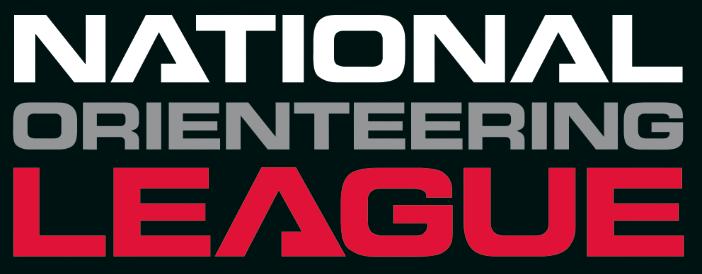

Top six results for the individual sprint in Queensland were:
3 Brodie Nankervis TF T 6:59
4 Patrick Jaffe VI V 7:01
5 Owen Radajewski CC A 7:18
6 Callum White VI V 9:34
NOL sprint relay in Queensland
Senior elite
Sam Woolford’s clean sweep of the four days of Easter has wrapped up the junior men’s competition with a round to spare, but the other three individual titles are still up for grabs. Brodie Nankervis’s two wins on the opening weekend (including a 7-min margin in the middle distance) and consistent performances thereafter see him ahead of Alastair George, despite George’s sweep of the Easter forest days. Grace Crane’s Easter sweep sees her in front despite missing the Queensland rounds, but two wins in Queensland and two in Tasmania for Caitlin Young sees her still in touch, while Milla Key and Nea Shingler have traded wins all season with the Victorian just in front as the season reaches its climax. The junior women regularly outperformed their senior counterparts in sprint events on the same course, and were joined in this by the junior men when Cooper Horley took out the knockout sprint in Queensland.
M20E (3.3 km)
1 Cooper Horley ST N 13:52
2 Oscar Brown CC A 14:50
3 Callum White VI V 14:52
Seth Sweeney ST N 15:18 MEN
1 NSW Stingers: Serena Doyle, Alastair George, Ewan Shingler, Nea Shingler
2 SA Arrows: Olivia Sprod, Ethan Penck, Leith Soden, Emily Sorensen
3 CBR Cockatoos: Tara Melhuish, Toby Lang, David Stocks, Caitlin Young
1 NSW Stingers: Erika Enderby, Cooper Horley, Seth Sweeney, Eszter Kocsik
2 VIC Vikings: Milla Key, Callum White, Torren Arthur, Sophie Taverna
2 CBR Cockatoos: Aoife Rothery, Owen Radajewski, Oscar Brown, Justine Hobson
Owen Radajewski CC A 15:17
14 THE AUSTRALIAN ORIENTEER JUNE 2024 NOL REPORT
M21E (3.3 km) 1 Patrick Jaffe VI V 12:59 2 Ethan Penck SW S 13:07 3 Alastair George ST N 13:08 4 Ewan Shingler ST N 13:26 5 Brodie Nankervis TF T 13:40 6 Aston Key VI V 13:43 W21E (2.9 km) 1 Caitlin Young CC A 15:04 2 Mikayla Cooper TF T 15:35 3 Emily Sorensen SW S 16:30 4 Tara Melhuish CC A 16:45 5 Olivia Sprod SW S 16:52 6 Evalin Brautigam SW S 17:12 W20E (2.9 km) 1 Nea Shingler ST N 14:44 2 Milla Key VI V 15:24 3 Sophie Taverna VI V 16:18 4 Justine Hobson CC A 16:33 5 Erika Enderby ST N 17:11 6 Eszter Kocsik ST N 17:35
50:25
51:30
51:32
Junior elite
52:18
53:30
56:43
4
5
Euan Best TF T 15:14
6
Start of sprint relay in Brisbane. Photo by Eszter Kocsik.


Top six results for the individual sprint HOF24 NOL1 were:
M21E (3.3 km)
1 Brodie Nankervis TF T 14:04
2 Ethan Penck SW S 14:59
3 Angus Haines SW S 15:06
4 Leith Soden SW S 15:06
5 Joseph Dickinson TF T 15:28
6 Toby Lang CC A 15:32
M20E (3.3 km)


Top six results for the individual sprint HOF24 NOL2 were:
M21E (3.5 km)
1 Alastair George ST N 15:16
2 Ewan Shingler ST N 15:21
3 Brodie Nankervis TF T 15:27
4 Leith Soden SW S 15:39
5 Ethan Penck SW S 16:13
6 Angus Haines SW S 16:22
14:58
W21E (2.6 km)
1 Caitlin Young CC A 14:37
2 Julia Gannon QC Q 15:17
3 Mikayla Cooper TF T 15:21
4 Emily Sorensen SW S 15:43
5 Hanny Allston TF T 15:55
6 Serena Doyle ST N 16:32
W20E (2.6 km)
1 Nea Shingler ST N 14:09 2 Erika Enderby ST N 14:49 3 Milla Key VI V 15:00 4 Zoe Carter SW S 15:04
W21E (3.1 km)
1 Mikayla Cooper TF T 16:35
2 Grace Crane CC A 17:11
3 Caitlin Young CC A 17:21
4 Emily Sorensen SW S 17:38
5 Hanny Allston TF T 17:55
Top six results for the middle HOF24 NOL3 were:
M21E (6.1 km)
1 Brodie Nankervis TF T 46:06
2 Toby Wilson ST N 53:54
3 Jiri Vales TF T 54:22
4 Angus Haines SW S 54:39
5 Leith Soden SW S 54:56
6 David Stocks CC A 55:15
(5.6 km)
6 Julia Gannon QC Q 18:11 W21E (5.1 km) 1 Caitlin Young CC A 50:33 2 Grace Crane CC A 55:02 3 Natasha Key VI V 58:10 4 Mikayla Cooper TF T 59:53 5 Veronika Kubinova TF T 62:07
W20E (3.1 km)
1 Milla Key VI V 16:32
2 Nea Shingler ST N 16:48 3 Zoe Carter SW S 16:55
Erika Enderby ST N 17:25
6 Ellie de Jong QC Q 62:08
5 Mikaela Gray QC Q 15:37 6 Justine Hobson
Justine Hobson
15:54
JUNE 2024 THE AUSTRALIAN ORIENTEER 15
CC A
5
CC A 17:39 6
TF T 17:49 W20E
1
Key VI
44:44 2
ST
46:53 3
CY Q 47:42 4 Natalie Miller CC A 48:38 5 Eszter Kocsik ST N 48:47 6 Justine Hobson CC A 50:33
4
Liana Stubbs
(4.5 km)
Milla
V
Erika Enderby
N
Mikaela Gray
VI V 15:57 5 Owen Radajewski CC A 15:58 6 Oskar Mella ST N 16:13 M20E
1 Cooper Horley ST N 15:11 2 Alvin Craig ST N 15:43 3 Euan Best TF T
4 Owen
CC A
5 Sam
ST N
6 Niko Stoner TF T 16:54 M20E
1
ST
2
ST
3
White VI V
4 Alvin Craig ST N 42:45 5
TF T
6
TF T
1 Alvin Craig ST N
2 Sam Woolford ST N 15:07 3 Cooper Horley ST N 15:19 4 Torren Arthur
(3.5 km)
15:49
Radajewski
16:26
Woolford
16:45
Sam Woolford
N 39:11
Oskar Mella
N 42:01
Callum
42:09
Niko Stoner
43:37
Euan Best
44:19
Caitlin Young and Justine Hobson, both ACT. Kate Braid (WA) in the background at HOF24 in Tasmania. Photo by Mike Dowling.
Ellie de Jong (QLD) and Natasha Key (VIC). Photo by Mike Dowling.
Callum White (VIC) and Leith Soden (SA) in Queensland. Photo by Eszter Kocsik.
HOF24 in Tasmania. Jett McComb (TAS). Photo by Mike Dowling.

NZ Taitonga South Island Orienteering Champs 2024

We decided to combine our family holiday back home to Christchurch with the South Island Orienteering Championships, which meant we had three generations at the one event as I convinced my dad to dust off the compass (and be careful due to a false hip) thus spanning M70A, M/W40A and W12A.
The champs were a three-day event held over ANZAC weekend, located on the Otago Peninsula at Dunedin. The weather gods smiled as although cold (5-10˚ C when running) it didn’t rain and the wind eased off.
First event was the sprint, which covered ground across a school, church, market gardens, a field with horses, and if you were lucky a last control that gave the option of going down a slide. There were so many controls that checking numbers was super important, I nearly mispunched the last control.
The long distance was on the 315 m high volcanic ‘Harbour Cone’, near Larnach Castle. It was very steep farmland, no marked fences, some rocks, pockets of bush, new plantings with deep grass, thickets (gorse) and ruins. Sounds like you’d be able to see the controls but they were placed cleverly so you needed to be super close. Decisions involved either contouring via sheep tracks or down into a marsh and up.
It was so steep that the start was 200 m above the finish, and a shuttle bus had to take you up. Each course still had climb but it was a lot of fun doing more down than up. Unless you were on the elite course with 11 km and 755 m of climb.
The final day was middle distance, right out at the end of the peninsula where the sea lions sunbake, and so some controls had to be modified. Farmland on sand dunes with 2.5 m contours and variable marshes. Technically challenging as it all looked the same, the key was to stay in contact with the map. It was also full of rabbit holes, and as luck would (not) have it I managed to stand in one and break my ankle.
Apart from a dramatic end we all had a great time and caught up with orienteers from 25 years ago I used to run with as a junior, still going strong. Highlight results were me winning the sprint (W40A) by 40 s and the long (W40AS) by 9 s, Tiffany Palmer coming third in the sprint (W12A), and Matt Palmer winning the middle (M21AS).
WESTERN AUSTRALIA
Albany, Flinders Park Primary (54 starters) Jumbuck Training (29)
VICTORIA
Bike-O 75 Event 4, You Yangs Regional Park (44)
Mornington Peninsula Sunday, Sorrento (5)
Sunday Morning Sprint, Melbourne University (95)
SOUTH AUSTRALIA
SA Sprint Distance Championships, Aberfoyle Park HS (111)


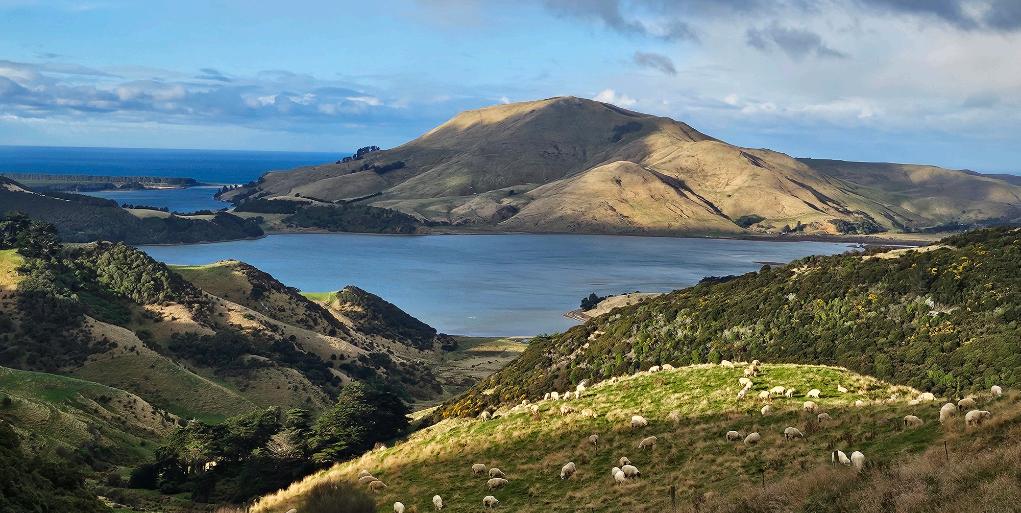
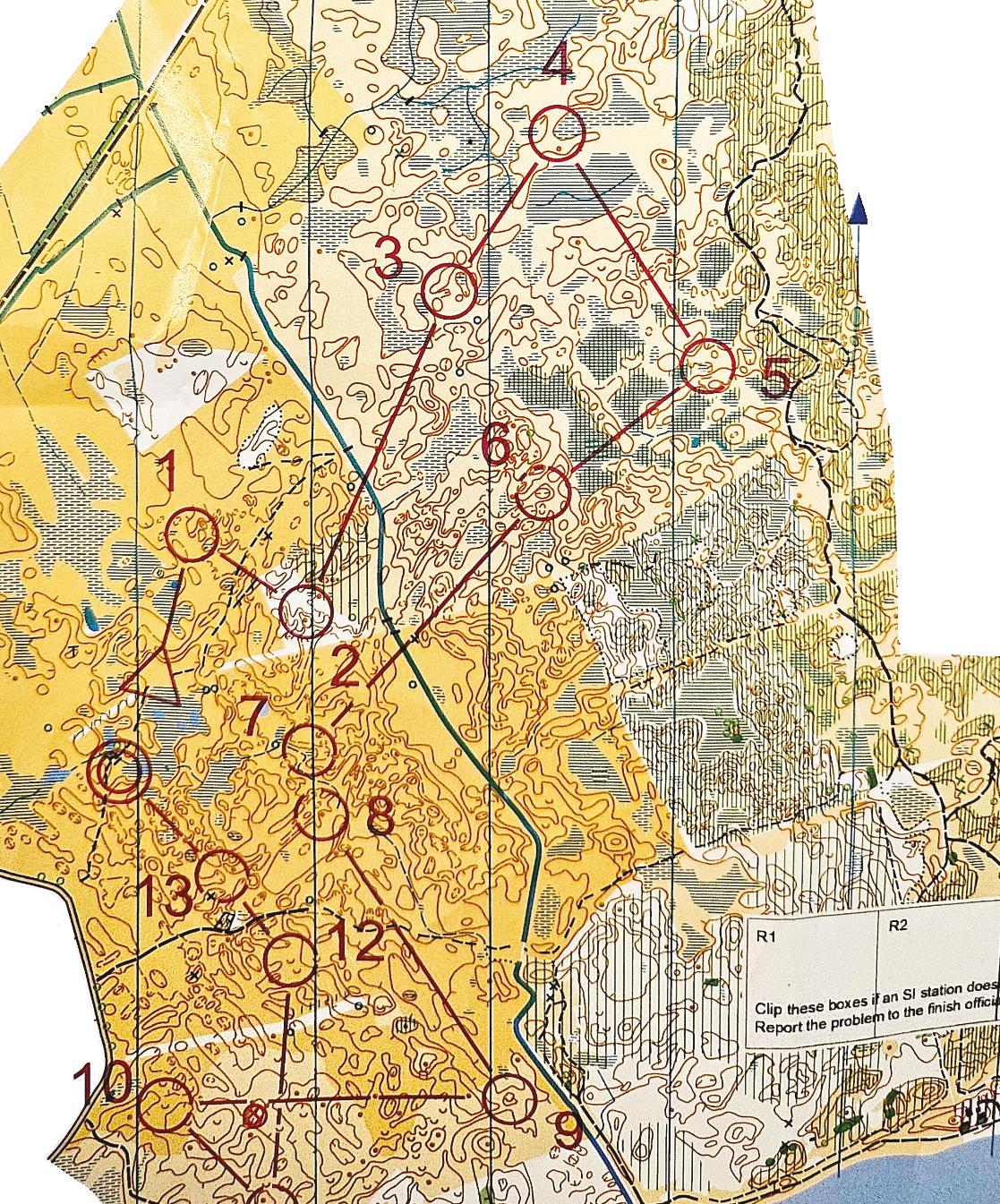
Orienteering on March 2-3 2024 in Australia, first weekend of autumn –
ACT
ACT Sprint Championships, ACT League #1, Amaroo Schools (132)
NSW
SOS 3D, Killara (170)
SOS MacArthur, Macquarie Fields (55)
O’Shea 2 Days 2024 race 1, Rumbalara & East Gosford (43)
O’Shea 2 Days 2024 race 2 (night), Rumbalara & East Gosford (39)
O’Shea 2 Days 2024 race 3, Rumbalara & East Gosford (40)
Waggaroos Summer Series 2023-24 #6 (6)
Women in Sport Expo, Speers Point Park (20)
Illawarra Map Running Summer Series #4, Shell Cove (36)
Goldseekers Bush Series, Lake Canobolas (22)
QUEENSLAND

Park O, Teralba Park Everton Park Scout Qld (58) Sprint Series - EN - Event 4, Oakleigh SS (86)
MapRun Parks 2024, 7th Brigade Park (28)
Charlie’s paddock coaching for beginners (23)
OY1 Sprint, Pacific Pines SHS (110)

16 THE AUSTRALIAN ORIENTEER JUNE 2024 ORIENTEERING IN NZ
TOTAL PARTICIPATION 1206 Queensland
scouts orienteering.
SA Sprint Championships. Photo by Evalin Brautigam website evalinmae.smugmug.com
Charlotte Marra
South Island Orienteering Champs. Middle distance.
Otago Peninsula.




Foot orienteering:
Gustav Bergman (SWE), Eef van Dongen (NED), Eline Gemperle (SUI), Brodie Nankervis (AUS).
MTB Orienteering:
Vojtech Ludvik (CZE), Jana Hnilica (AUT), Karin Gustafsson (SWE), Will Whittington (AUS).




JUNE 2024 THE AUSTRALIAN ORIENTEER 17 Aston Key –JWOC Gold Denmark 2019, Athlete of the Year 2021 & 2022. Str8 Kompakt Compass with Str8 Magnifier and Nvii Crazy Light Forest 1 Shoes. Nvii & Str8 are Now Available in Australia www.melbournebicycles.com New IOF Athlete Representatives elected
Will Whittington (AUS).
Brodie Nankervis (AUS).
Course setting by juniors
Orienteering ACT recently completed its second Sprint Series set by juniors. Let’s hear what two of the course setters have to say about it.
Interview with Oliver Bishop
Susanne Harrysson: How did you start orienteering?
Oliver: Another family told us to come along to a regular event. We did, and just kept coming back. It was fun. Then I joined the training squad Blue Lightning. There I ran with a friend, and someone shadowing. That worked really well.
S: As a junior and an ASOC representative you were asked to set a course for the Sprint Series. What were your initial thoughts?
O: I was intrigued, happy to set a course. At the same time I was slightly nervous, felt a bit of pressure to set good enough courses for all these experienced people. But it was okay. I felt mostly happy about getting the chance to do it.
S: What would you say were your biggest challenges?
O: Apart from the internal pressure, I’d say it was to get good route choices. Initially some of my controls only had poor route choices, and needed to be changed. But every change caused another issue somewhere else. It was tricky to get it right. I had never used Purple Pen and there was a lot to learn and figure out there. I had a mentor, David Stocks, which was great. He helped me a lot, both with Purple Pen and controls checking, and he taught me some tips and tricks around course setting.
S: Now that you have set your first course, did you learn anything useful, and will your own running benefit from the experience?
O: Absolutely, I learnt a lot. To know Purple Pen will help in the future. For my own running I didn’t know what everything meant on the control description, now I do. That really helps. And I’ve got a better understanding of course setters, what they had in mind when they set the course – and, I’m better at finding good route choices.
S: What are your thoughts about letting juniors set the courses?
O: Good, because there aren’t that many people that can set courses, the same people tend to do it again and again. We need more course setters. Really good orienteers are also good course setters, so it is good for us to be able to course set early. One day, we will be seniors too.
S: What would you say to other juniors around Australia if they were reluctant to set their first course?
O: I’d would tell them to just do it: you will have to do it sooner or later, might as well learn now, AND to become a good orienteer – you need to be able to set courses. When setting yourself, you actually become better at reading the map and finding the best route choices, so it is also a way to improve your orienteering skills. But mostly I’d say: Course setting is fun! Not a job that has to be done!
S: Middle, long or sprint – what do you choose?
O: In general, not sprint, for course setting yes, but for running I prefer bush. I like the contours in particular. Earlier I would have chosen long, but now that I have moved up to M16 I prefer middle. I like the control picking. But overall, I really like relays. They are the most fun! There is a lot of cheering and team spirit and so.

18 THE AUSTRALIAN ORIENTEER JUNE 2024
D e t a i l n o t m a p p e d M a p p e d b y P a t r i c k M l e r T r s t a n M l e r a n d F r y d e r y k P r y j m a U p d a t e d F e b 2 0 2 4 b y D a v i d S t o c k s C o p y r g h t O r i e n t e e r n g A C T 2 0 2 4 s c a l e : 1 : 2 5 0 0 i n t e r v a l 2 5 m O r a n a S c h o o l A C T S p r i n t S e r i e s R a c e 1 0 1 2 3 4 5 6 7 O r a n a S p r i n t C o u r s e A - 1 2 4 k m 1 2 3 4 5 6 7 2 0 1 2 0 2 2 1 8 2 2 6 2 1 9 2 0 7 2 1 3
Oliver.
Photo Tom de Jongh, website
JUNIOR COURSE-SETTING
PhotosByTom.com
Interview with Aoife Rothery
Susanne Harrysson: How did you start orienteering?
Aoife: My parents did orienteering before I was born, so I have been doing it for my entire life, but I have also done it on many different school camps and school programs like SC-ORE in the ACT.
S: As a junior and an ASOC representative you were asked to set one of the courses in the Sprint Series. What were your initial thoughts?
A: At first, I thought that having a lot of courses set by the ACT juniors was a very interesting idea and would be a good opportunity for the Sprint Series to have some new ideas and people setting the courses, but I wasn’t sure if I wanted to do a course because it seemed like a big commitment.
S: How did you go?What would you say were your biggest challenges?
A: The biggest challenges I found were organising things with the school and working around things like staying off the community oval and leaving areas near the carpark free for other weekend sports that were held at the school. Other than this, I found setting the courses and putting out controls was quite easy and enjoyable.
S: Now that you have set your first course, did you learn anything useful, and will your own running benefit from the experience?
A: I think it will help with my running in the future to know what setters are thinking when they plan legs. For example, some legs in sprints aim to take runners from one part of the map to another, and it is important to focus on choosing a route that does not have many obstacles, and some legs have two route choices with similar distances, and it is important to pick an option and stick to it.
S: What are your thoughts about letting juniors set the courses?
A: I would definitely do this again and I think having more juniors set courses is a very good idea, to have variation in courses. This also means that in the future there will be a group of people who are already very experienced in planning events.
S: What would you say to other juniors around Australia if they were reluctant to set their first course?
A: I think that asking previously experienced setters like parents or older orienteers for help is a good idea. It can be overwhelming to find out where to start and how the courses should look like. This way you can provide your own ideas and make your own decisions with support rather than doing it all by yourself for the first time, and not knowing where to start.
S: Middle, long or sprint – what do you choose?
A: I have not set a bush event, but I think I would prefer setting sprint events. There are more opportunities to make runners think about their route choices and how to approach controls. For running, I really like relays and long events because I feel like I am less likely to get lost on these courses because the setting in middles can usually be very technical and in thicker bush.

JUNE 2024 THE AUSTRALIAN ORIENTEER 19
0 2 0 5 0 1 0 0 m S c a l e 1 : 2 , 0 0 0 M a p p e d b y D u n c a n C u r i e 2 0 2 3 C p y g h O g A C T 2 0 2 4 a c t o r e n t e e n g a n a u G o l d C r e e k S c h o o l s A C T S p r i n t S e r i e s 2 8 J a n u a r y 2 0 2 4 1 2 / 5 3 4 6 7 8 9 1 0 1 1 1 2 1 3 1 4 1 5 G o l d 2 8 J a n 2 0 2 4 A - 1 2 2 k m 1 2 3 4 5 6 7 8 9 1 0 1 1 1 2 1 3 1 4 1 5 2 1 6 2 2 2 2 2 1 2 0 5 2 2 2 2 1 8 2 2 0 2 1 7 2 1 9 2 0 3 2 0 4 2 2 5 2 0 6 2 0 7 2 0 8
Aoife.
Photo Tom de Jongh, website
PhotosByTom.com
Susanne Harrysson, President of OACT:
How did you start orienteering?
S: Like Aoife, I was born into the sport. My dad had run since he was ten, so it was natural for me to pick it up as well. I remember attending a beginners’ course at the local club when I was eight, and continued from there.
Asking juniors to set orienteering courses, what were your thoughts?
S: Well, orienteering is run almost exclusively by volunteers. The cohort is ageing, and many are stretched to the limit, so we need to find new ways and extend our volunteer base. That’s where juniors came to mind. I thought they would be up for the challenge and to get new experiences, while off-loading our regular course setters. And, maybe in the future they will be willing to set bush events as well?
How did it go? What have been the biggest challenges?
S: Really well, I’d say, but I might be biased. The juniors did a great job course setting, lots of positive feedback from participants. Permissions on the other hand have by far been the biggest challenge this year, to get responses and approval from venues. Overall, the series has been trimmed to a lower workload than other event series - both online registration and having only one course have made it easier from an organising point of view.
Anything you would change for the next series?
S: Maybe. We received some feedback that the course was too long for beginners and the youngest runners, so we experimented by offering a short beginners’ course a couple of times, using existing controls. We might continue with that. At the same time we want to keep the workload down for all involved. We will see. It is an option to consider.
What would you say to other states if they consider letting juniors set courses? Any tips?
Go for it. It is good way to get more volunteers, at the same time as the juniors get to see what goes into organising events

and to look at the map and the courses from a course setter’s perspective – a great way to further improve their skills. You will need a series coordinator, and I do think it is important to assign a mentor of some kind to each first timer – someone to help them get started without getting overwhelmed, to learn the course setting tool and to discuss with along the way. Our juniors were offered mentoring, which some took up, and some used more experienced family members as mentors instead. There is a lot to think about, so a second set of eyes is useful and a security at the same time.
Middle, long or sprint – what do you choose?
Difficult choice. Used to be long, but sprint is catching up. If I'm forced to choose, I'd probably still say long on a technically difficult map, closely followed by sprint.
Australian Junior Development Camp 2024
The Australian Junior Development Camp 2024 will be held most likely in December before Christmas this year. Look out for more information soon.
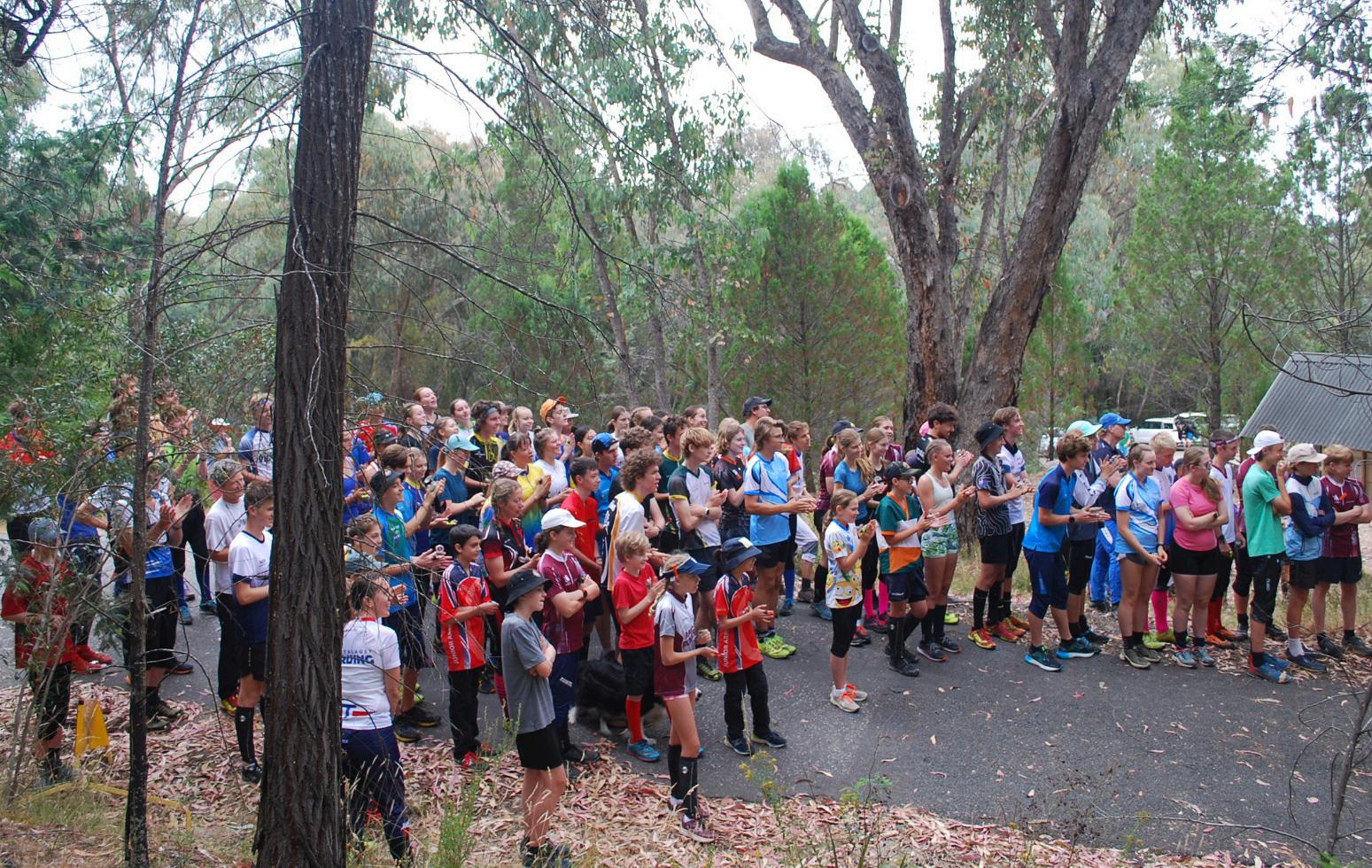


20 THE AUSTRALIAN ORIENTEER JUNE 2024
JUNIOR COURSE-SETTING
Susanne Harrysson. Photo by John Harding.
Sydney City Race
Sunday 13th October 2024

Sponsored by



$1000 first place prize on the 15k course
Male & Female
Starts from 8:00am 5 courses, including a Score, to suit everyone
SYDNEY CITY RACE UPDATE
12th and 13th October 2024
The inaugural Sydney City Race weekend is coming! Right after the Australian Orienteering Champs carnival, withtwo urban orienteering races in iconic and world famous locations:
Saturday afternoon 12/10/24 - Pyrmont
Sunday morning 13/10/24 - Sydney City
Saturday 12 October 2024, starts 2:00-3:30 pm, Pyrmont
Originally scheduled for Cockatoo Island, we have relocated to Pyrmont to avoid the Mode Music Festival on the island at the same time.
This event is a short distance race in part of Sydney's former industrial waterfront of wharves, old shipbuilding yards and woolstores, and provides a perfect warm up for Sunday as it’s right next door! 3 distances to choose from, all with anticipated 15min winning times, as well as a 30min Score course.
Sunday 13 October 2024, starts 8:00-11:00 am, Sydney City & Harbourside
Sponsored by BridgeClimb Sydney, the first ever Sydney City Race is a long-distance urban race, visiting amazing sites in the city of Sydney and its harbourside surrounds. There are $1,000 men's and women's first place prizes for the15 km race, which has a strict entry limit and a very unique and exciting control site! There will be five racesto choose from: 15 km, 10 km, 6 km, 3 km and a 60 min Score.
Individual and Teams Divisions in all races
All of our races across the weekend can be run as an individual or as part of a team. So whether you want to run on your own, or with family and friends, there’s something for everyone! You don't want to miss this - for more information go to www.sydneycityrace.com.au where you can also register for updates. Weekend Race Director is Sheralee Bailey, Bennelong Northside, email: sheraleebaileyonsw@gmail.com.
JUNE 2024 THE AUSTRALIAN ORIENTEER 21 Spectacular urban orienteering! New Venue for Warm up event, now at Pyrmont Saturday 12/10/24
sydneycityrace.com.au

AUSTRALIAN ORIENTEERING CHAMPIONSHIPS CARNIVAL 2024
The Armidale/Uralla region is the location for this year’s AOC. It is a section of the Granite Belt which runs along the Great Dividing Range. The Granite Belt has played host to many State and National Championship events.
The Australian MIDDLE, RELAY and LONG Championships will all be held on a new map. The same arena will be used for all three events. The terrain is granite rock of all shapes and sizes with mostly open running, with gentle slopes. It will showcase the best orienteering we can provide– great mapping, high quality course setting and high quality event presentation both in the arena and online.

The Australian Schools Championships–SPRINT, LONG and RELAY will be held during the week. The Sprint at The Armidale School and the Long and Relay at Pine Tree. The Thunderbolts 3 Day will be held in conjunction with the schools events.

The Australian SPRINT Championship will be held at the University of New England. This map has previously been used but will be updated to the new sprint standard. A typical university campus with a slope from north to south.

There is a large range of tourist activities as well as cultural activities to experience on the rest days. Accommodation is available in both Armidale and Uralla–caravan parks, motels etc; Armidale Showground offers large sites, powered and un-powered for campers and caravans. There is a camp kitchen and large clean amenities block with laundry facilities. Well located minutes away from Armidale’s city centre and within easy reach of shopping, restaurants and entertainment opportunities. The Showground camping area is spacious and uncluttered.
For more event details, accommodation and tourist information see AOC 2024 website
Bulletin 1
ASOC Bulletin 2
Entries on Eventor

22 THE AUSTRALIAN ORIENTEER JUNE 2024

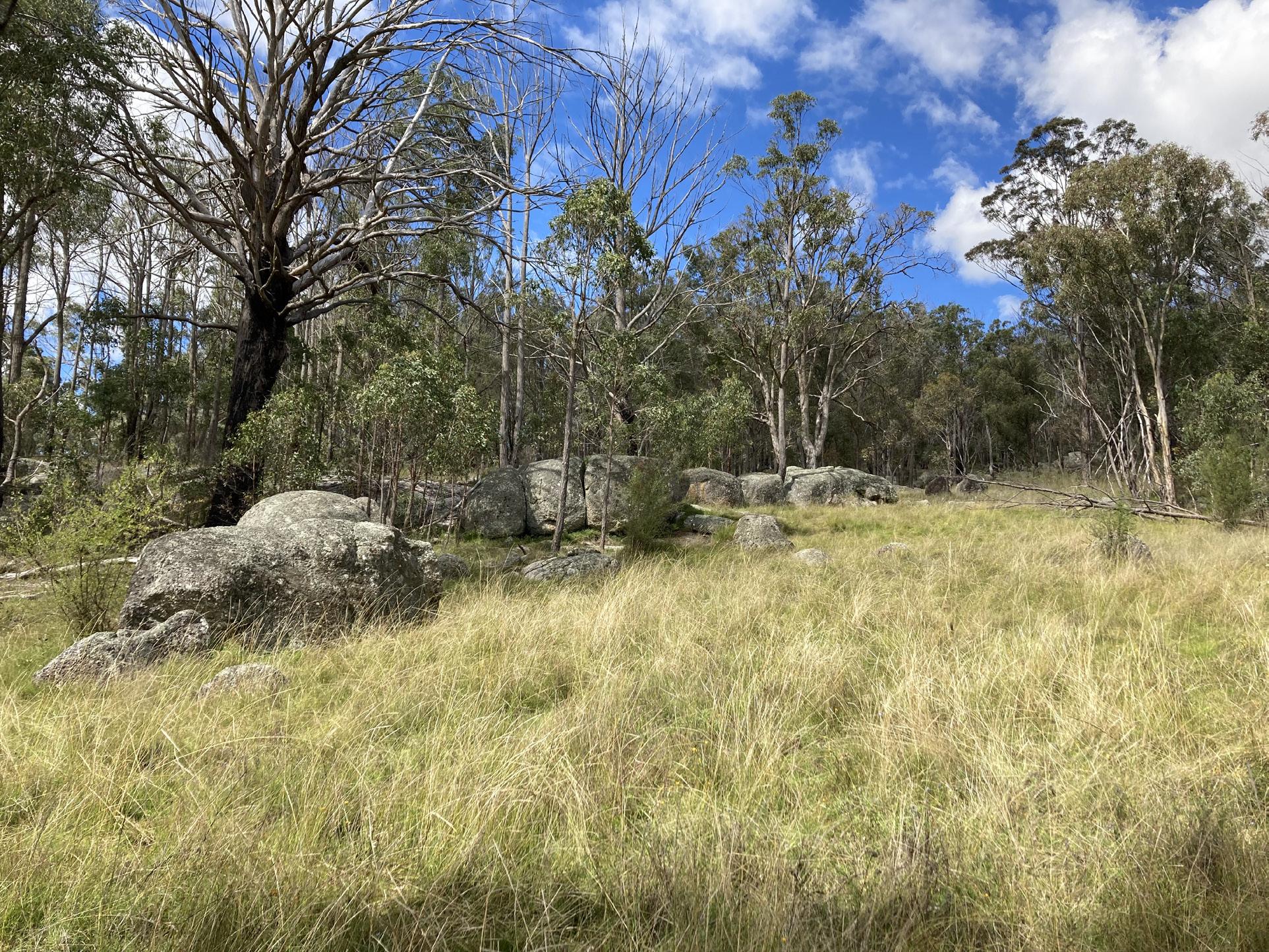
Extract from an article about training by Oskar Andrén, courtesy of Orienteraren 04-2023
Translation from Swedish by Martina Craig
Don't forget to have fun
In the sprint discipline, I would like to focus on practising what may be the most important technical aspect - mastering the switch from planning ahead, to being in the moment, making the right decisions. Loops where we switch between line orienteering and demanding route-choice legs will challenge us to practise this skill. We need to make sure we stay on the line at the same time considering route choices and deciding on how to execute the long leg.



JUNE 2024 THE AUSTRALIAN ORIENTEER 23 4 ARENAS 9 DAYS EVENTS ARMIDALE 35 km 23km 21km 33km URALLA 3 7 7 AUSTRALIAN SPRINT DISTANCE CHAMPIONSHIP 6 AUSTRALIAN LONG DISTANCE CHAMPIONSHIP 5 AUSTRALIAN SCHOOLS RELAY CHAMPIONSHIP 4 AUSTRALIAN SCHOOLS LONG DISTANCE CHAMPIONSHIP 3 AUSTRALIAN SCHOOLS SPRINT CHAMPIONSHIP 2 AUSTRALIAN RELAY CHAMPIONSHIP 1 AUSTRALIAN MIDDLE DISTANCE CHAMPIONSHIP SATURDAY 28TH SEPTEMBER aoc2024.com.au SUNDAY TO 6 TH OCTOBER
Come back to Clandulla land of our WMOC 2009 medallists!

Sheralee Bailey, Organiser 2024 NSW Champs weekend, sheraleebaileyonsw@gmail.com
The 2024 NSW Middle and Long Distance Championships are on 7 and 8 September at Clandulla, which is one of our most significant orienteering areas as it was where Aussies dominated the World Masters Orienteering Championships (WMOC) 15 years ago in 2009. Held as part of the World Masters Games in Sydney, we won six gold, six silver and three bronze medals at Clandulla.
For those of you who have run at Clandulla before, you will no doubt remember the extensive and detailed sandstone cliffs which required meticulous navigation and picking the gaps. If you haven’t previously run on Clandulla, or are desperate to get back there again, you finally have the chance this year! We will be using the best parts of the map for the weekend. So with Eric Morris (BN) setting the Middle Distance Championships on Saturday, and Ant Nolan (UR) setting the Long Distance Championships on Sunday, we are in for a fantastic weekend of top quality orienteering, just a few weeks before the Australian Orienteering Championships carnival in Armidale. You can’t ask for a better prep event!
To truly appreciate the significance of Clandulla for orienteering in Australia, we have to look back in a bit more detail at WMOC in 2009. This is where we really showed how strong a nation we are when fully represented across age groups, particularly when some unique technical sandstone terrain is thrown into the mix. This was the third time* in 17 years that Australia was a host country to WMOC, and we sure took advantage of that, winning a staggering 28 of the medals that were on offer across the sprint- and long-distance events, 13 of them being gold. That made us the most successful nation at WMOC 2009! (*Note: Blair tells me that technically it was the second time we hosted the WMOC, as the first edition was the Veteran World Cup).

NSW CHAMPS MIDDLE & LONG CLANDULLA
7th & 8th Sep 2024


So where do we start with who those medal winners were at Clandulla? It’s probably no surprise as they are some of Australia’s best masters orienteers – back then, and now. Natasha Key (W35), Jenny Bourne (W55) and Warren Key (M50) all won gold at both Clandulla and the sprint race in Sydney. Paul Pacque won Clandulla gold in M55 (going one better than his sprint silver), with Cath Chalmers also taking gold home from Clandulla in W40. And we will never forget Hermann Wehner who lives in our memories now and won that elusive gold medal in M85. That’s six gold medals won by Aussies –who will come back to Clandulla in September to reclaim victory?

24 THE AUSTRALIAN ORIENTEER JUNE 2024 CLANDULLA 2009 AND 2024
Clandulla creek. Photo by Ant Nolan.
Clandulla rock. Photo by Ant Nolan.
Clandulla rock control. Photo by Nick Dent.
WMOC 2009 Gold
Clandulla longdistance medal winners**
Sydney sprintdistance medal winners**
Natasha Key W35
Cath Chalmers W40
Jenny Bourne W55
Warren Key M50
Paul Pacque M55
Hermann Wehner M85
Natasha Key W35
Su Yan Tay W45
Jenny Bourne W55
Maureen Ogilvie W75
Warren Key M50
Kevin Paine M80
Hermann Wehner M85


Anna Hyslop W35
Su Yan Tay W45
Liz Abbott W50
Grant Bluett M35
Ted van Geldermalsen M55
Ray Kelly M80
Jenny Enderby W40
Anthea Feaver W50
Paul Pacque M55
Jenny Enderby W40
Anitra Dowling W60
Neil Schafer M80
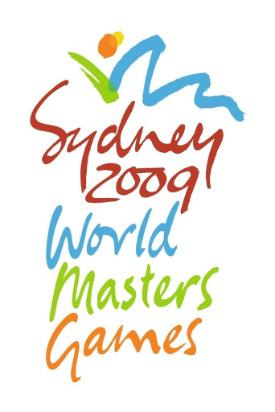
Bruce Arthur M35
Clive Pope M70
Neil Schafer M80

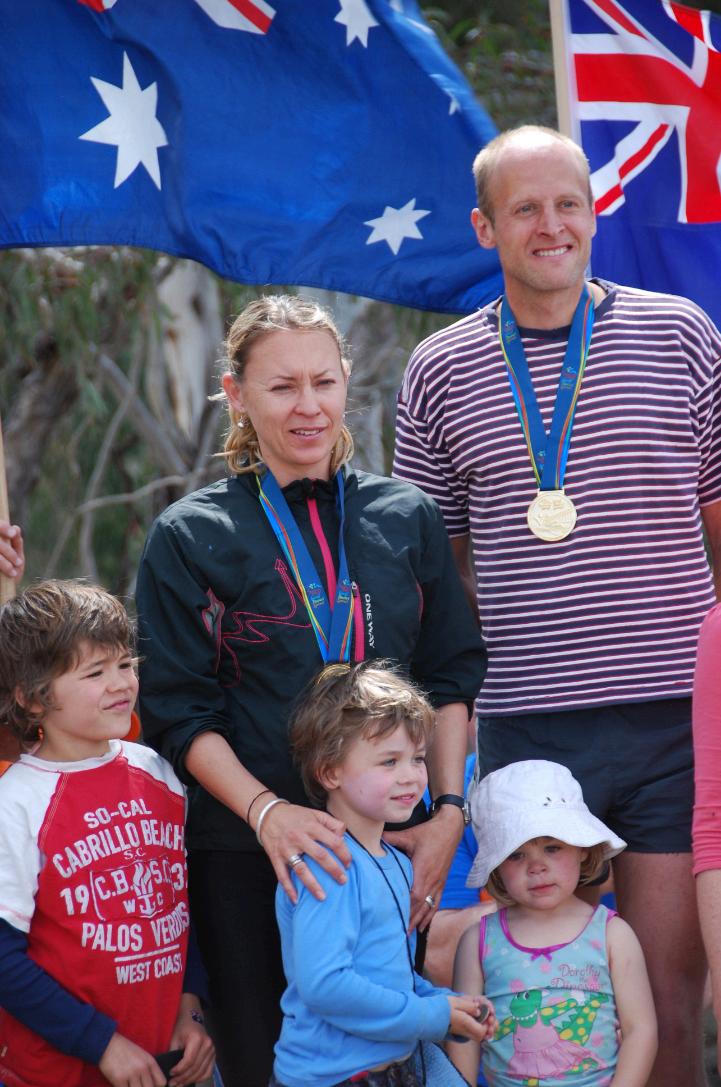
**Blair also tells me that some of them are not technically Australian, but we are definitely happy to claim them as Aussies! (It’s the Aussie way isn’t it?)

Full WMOC 2009 results are available on the World Masters Games site here: https:// d3tfdru9q5sbcz.cloudfront.net/ 2020/08/2009-All-OrienteeringResults.pdf
Details about the 2024 NSW Champs weekend at Clandulla are on Eventor here: https://eventor.orienteering.asn. au/Events/Show/19591
JUNE 2024 THE AUSTRALIAN ORIENTEER 25
Bronze
Silver
Cath Chalmers (won W40).
Hermann Wehner (won M85).
Jenny Bourne (W55) and Paul Pacque (M55).
Warren Key (won M50).
WMOC photos by John Harding.
Winners Natasha Key (W35) and NZ’s Carsten Joergensen (M35).
Applying for funds from the Moira Whiteside Orienteering Bequest
Interview with Tate Needham
Hania Lada: Congratulations on your successful application with Fedor Iskhakov and Michael Reed for a grant from the Moira Whiteside Orienteering Bequest.
Tate Needham: Thanks Hania! We are very excited and grateful to have been awarded a grant from the Moira Whiteside Bequest. It will really give a boost to this project and bring its timeline forward.
H: First, please tell us about yourself as an orienteer. Did any non-orienteering skills and experiences help you in getting the grant?
T: I have been orienteering since 1987 when it was my chosen school sport. After a hiatus after uni, I jumped back in and also introduced my kids and wife to orienteering. I especially enjoy travelling to new places and experiencing new maps, as well as all the social aspects and helping out where I can with mapping, course setting, controlling and I also had a stint on the OACT Board.
I studied Engineering at University and have fond memories of building computers using individual memory chips, CPUs, and other discrete components; connecting them all up with wires and then trying to make it work. In recent years I have tinkered with Arduino and other small electronics projects.
My career has been writing software for government, private companies as well as running my own software consulting business. I especially love creating mobile apps on iOS and even made one for myself for viewing, searching for and navigating to orienteering events in Australia. I released it a couple of years ago on the App Store - search for 'Aus O Events'! This radio control project has been combining both my hardware and software interests, and together with Fedor and Michael, we have a strong team.
H: What are you going to use the grant for?
T: Our grant application is for the development of a radio control system, with an implementation goal of using it for the Australian MTBO Championships in October. This project was started in 2020, but of course time and money tend to get in the way, plus it takes considerable effort to finalise a prototype to a device that can be used reliably in the field.
The current state of the project is that we have a working prototype, but with some rough edges, incomplete software, and not packaged. The grant money will be used to do some modifications to the PCB (printed circuit board) design and manufacture a small number of version 2 boards. Once these have been verified as working, then we will order a production run (or do a version 3). Then comes packaging the hardware in waterproof enclosures, so considerations such as how to run cables, what batteries to use, how to waterproof the antenna, how to mount the various components, etc. This process requires purchasing a lot of different parts and testing them out to see which ones work best for these radios.
Finally, our grant proposal was to produce 10 final units.
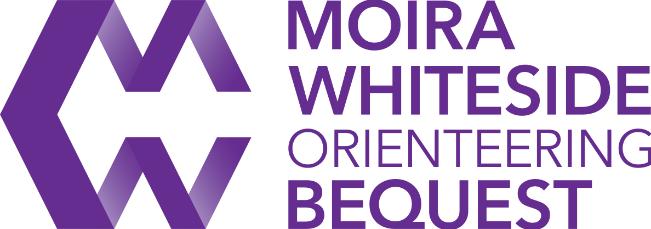


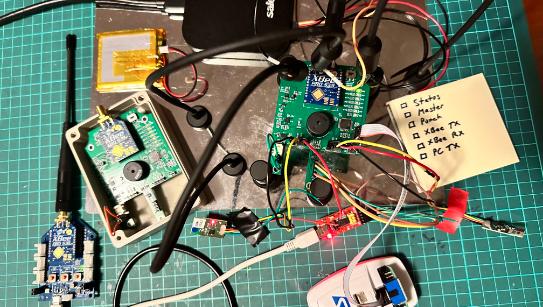

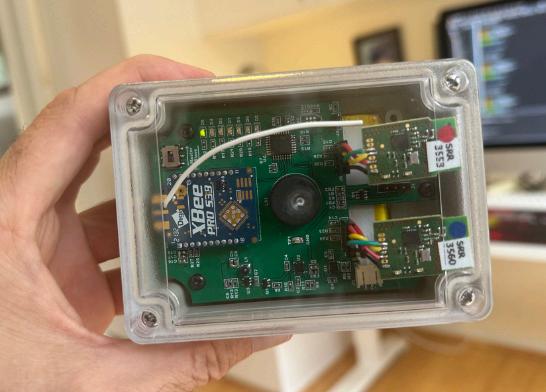
H: Could you please explain the process of applying for the grant?
T: We first approached the OACT Board in relation to financial assistance for this project, and they suggested we apply for the Moira Whiteside Bequest grant. It was then a process of doing a proper business plan and figuring out realistic timelines, approximate costs, and also including documentation of the current project state and a quote for another run of prototype boards. As a very technical project, it was important to explain not just the high level benefits (safety and live commentary), but also the difficulty and the various costs involved in bringing this kind of product to market. We also included some future directions once we achieve the first stage.
H: What advice can you give to other orienteers who have ideas about development of orienteering in Australia and would like some financial help with implementing them?
T: I think it’s important that a project is far enough along so that there’s a high level of confidence of success. Also - think of how such a project can progress orienteering, especially from a technology perspective, and how it fits in with Orienteering Australia’s Great Opportunities. I personally find that working in a team with others will significantly boost motivation, as well as combining everyone’s strengths and giving different perspectives. Talk to other orienteers and really investigate what kind of issues the sport has and how they can be improved.
26 THE AUSTRALIAN ORIENTEER JUNE 2024
Michael Reed, Tate Needham and Fedor Iskhakov.
Prototype.
Components.
MOIRA WHITESIDE O BEQUEST
Work in progress.
My orienteering trips by public transport
LOUISE BROOKS
(SOUTHERN HIGHLANDS ORIENTEERING CLUB)
I have been a member of an orienteering club in NSW for approximately seven years, and have mainly done Summer Series, metro league, which is a team competition introducing members to bush orienteering, and have done the odd state league, mainly doing moderate courses.

Oceania Championships 2024 in New Zealand
Last year I attended the Hobart Shorts after the Oceania Championships. I saw the Auckland Triple Crown advertised and I toyed with the idea of entering my first international event and eventually I took the plunge. I arrived in Auckland on the Thursday. Friday was a day to acclimatise visiting the Auckland Domain and collecting my bib Friday evening. I was impressed with the bag I was given.
Saturday, I woke early and headed off to a parkrun. I attended Western Springs. This was so I could complete my compass challenge where you do a parkrun with a compass point in the name. I often wonder whether orienteering could incorporate such challenges.
It was then back to my accommodation to rest before the first orienteering event which was at the University of Auckland. My accommodation was on the edge of the embargo area so I had to walk the long way around to enter the event arena.I chatted to some orienteers, watched the elites and headed up to the start. I got on the map ok and managed a clear round.The presentations were held, and I then headed to High St in Auckland which had a great selection of restaurants for dinner.
On Sunday I visited the SkyTower before heading to the event site. The public transport in Auckland made it quite easy.This event was held in a school, parkland and residential area. The bulletin said that the courses 1 to 5 would visit the latter. I was on course 6, so was surprised when I went into this area too. The first few controls on this map I found quite tricky. I also mucked up the final controls, heading down the hill to the control on a tree, forgetting that I had seen the final control as the crown on a pillar.
Monday was a rest day, and I was able to catch up with a friend, others took up the option of doing some map runs. Tuesday was the final event which was around the Viaduct. I walked to the event. The start was only a short walk from the arena. This map had lots of laneways and was quite intricate. Unfortunately I mispunched, which was disappointing as my goal was to get three clear rounds. I found at the events themselves that I was able to meet new people but I found it lonely in the evenings.I would recommend attending an international event, and hope that the Oceania Champs in 2025 will be held in an area that I would like to travel to.
Brisbane Sprints 2024
I did travel up to the National Orienteering League round 3 in Brisbane. I stayed at a hotel in South Bank on Friday night,which I got to by the Airtrain. On Saturday morning I attended a parkrun.
I followed the Brisbane transport website and was able to navigate my way to the first orienteering event at Griffith Uni. I got there with plenty of time before my event. It was a tricky course with lots of construction. A route choice was to weave your way around the fenced area or take the long way round . I was able to get a lift to the second event, which included a detour to the Mt Gravatt lookout. It had good views across to the city and bays, as well as a nice cafe to refuel.
The NOL relay was enjoyable to watch, and then I participated in my event. I did the moderate course and did at times find it hard staying on the map.I travelled back into the city via two buses with the first one right outside the school.
There was a social event organised for NOL competitors, family and friends on the north side of the river, but I did not attend it because I had an early flight the next day and I was staying on the south side. In hindsight, ifI had thought about it, I should have booked accommodation on the north side which would have made it easier to attend the social event. I look forward to attending the NOL round 4 mid May in ACT.

JUNE 2024 THE AUSTRALIAN ORIENTEER 27
PARTICIPATION
Changeover during the NOL sprint relay in Brisbane. Photo by Eszter Kocsik.
Louise Brooks at Oceania Championships 2024.

Spot the difference
What are the four main differences between the two maps?

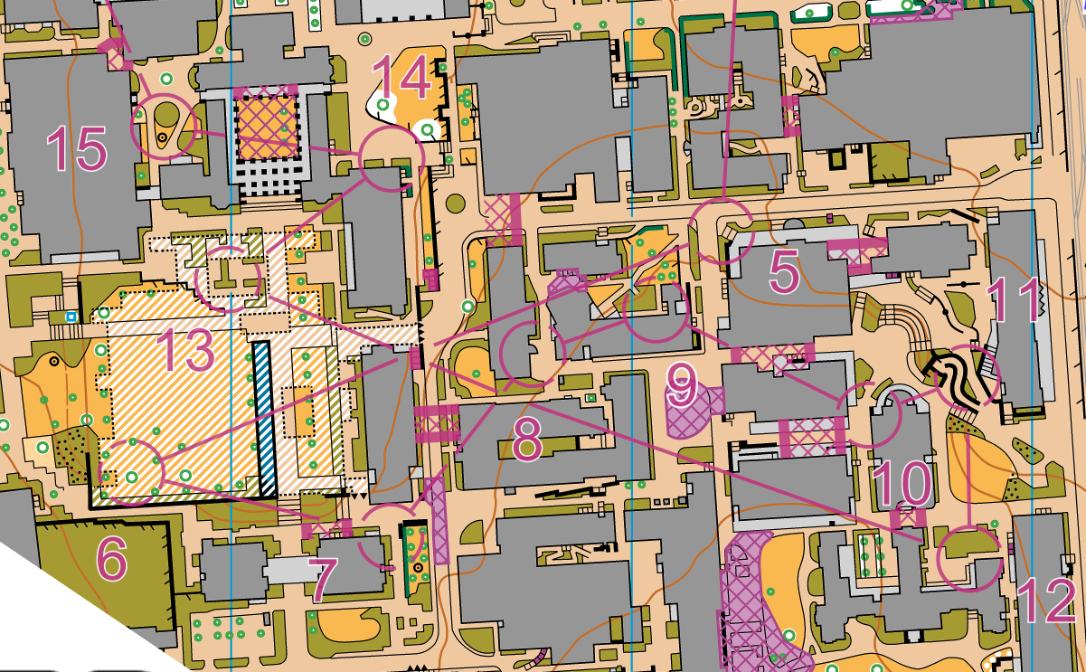
Quiz
1. On the left map above how many entrances are there to the underground car park?
A. None.
B. One.
C. Two.
D. Three.
E. Four.
2. On the left map above how many legs have route choices that may use the underground car park?
A. None.
B. One.
C. Two.
D. Three.
E. Four.
3. What does the rectangle with the thick black outline and diagonal blue and white stripes on the western part of the map represent?
A. Uncrossable underground canal, passable area on the top level.
B. Crossable water feature on the top level, passable area on the lower level.
C. Uncrossable water feature on the top level, passable area on the lower level.
D. Uncrossable water feature on the top level, parallel walls on the lower level.
E. Crossable water feature on the lower level, passable area on the top level.
The answers are on page 46.
Polish your skills
Draw on the map above on the right how you would go from control 6 to 7, and from 12 to 13. Then look at the map on the left. Do the extra features make you select a different route choice?
Link to post-print corrections/ quiz/survey

Follow this link to post-print corrections, quiz and survey on one form. Check out what mistakes in the current edition have been discovered too late, feel free to attempt some or all quiz questions, and provide data by completing the survey.
https://docs.google.com/forms/d/ 1Fj86VQlmQnC1kuxoWDfCa9s9enGPhw_ Zzf4Rtk8k9_s/edit
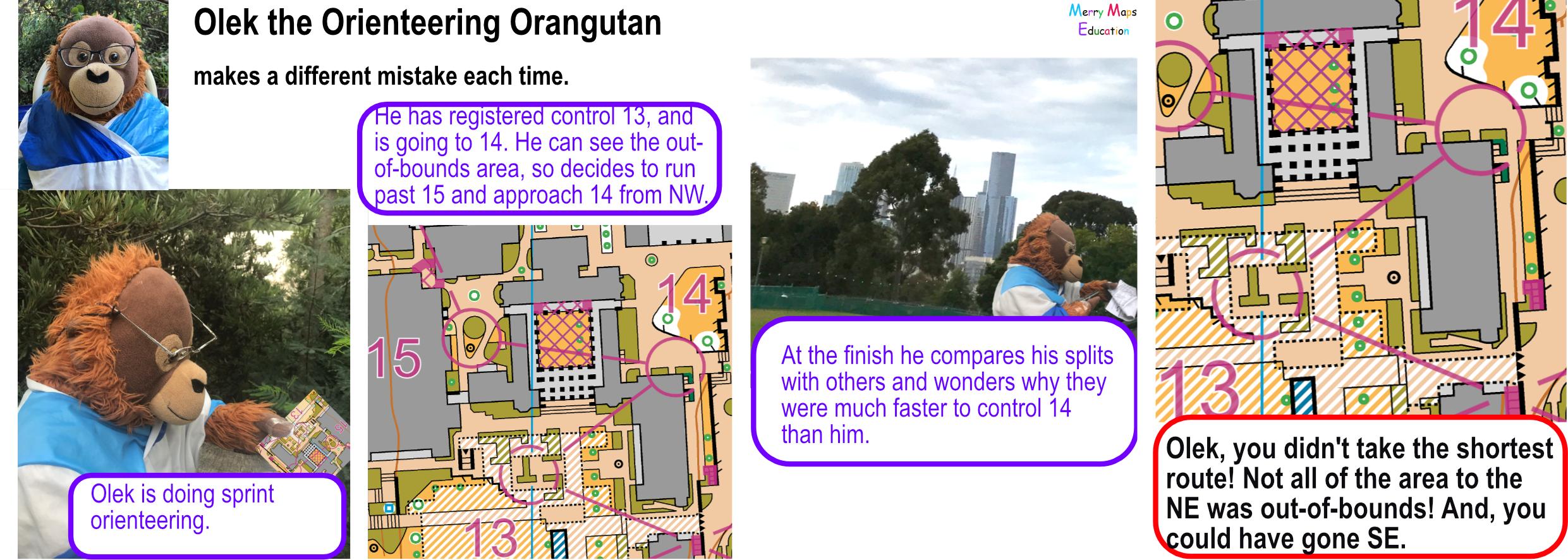
28 THE AUSTRALIAN ORIENTEER JUNE 2024
HANIA LADA

JUNE 2024 THE AUSTRALIAN ORIENTEER 29
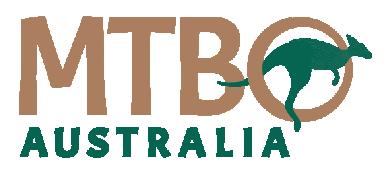







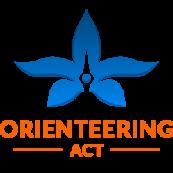
Event 0 – 17

OCTOBER (Thursday)
5 pm – BRUCE RIDGE - SCORE WARM-UP Event

The opening event of the carnival and championships is the Warm-Up Score event at the beautiful Bruce Ridge terrain. Even local people who practise here weekly can be lost in the intricate tracks of the Ridge located in the heart of Canberra. The Warm-Up event is designed in the Score format, and is a Model Event. Designed to sharpen your MTBO riding and prepare to the real challenges of the coming championships! Enjoy social drinks at the spacious open Terrace of Alivio Tourist park, the accommodation partner of the carnival located right here on the map!
Event
1 – 18
OCTOBER (Friday)
5 pm - STROMLO – MASS START CHAMPIONSHIPS
The first formal event of the championships is the Australian Mass Start Championships. Being the most recent format introduced to the Australian MTBO scene in 2019, this is only the fourth edition of the mass start format. The Mass Start Championships will take place on the hills adjacent to the iconic Stromlo Park. Riders will be welcomed by moderate-to-steep terrain with a network of fire trails and purpose-built mountain bike single track. Single tracks can be rocky with some obstacles. The area was previously a pine plantation, and while some stands of pine forest remain, it is mostly rough open land with pockets of native vegetation and fragments of open and semi-open ridable areas.
Event 2 – 19
OCTOBER (Saturday) 9 am
– STRINGYBARK HILL – MIDDLE CHAMPIONSHIPS
What can be more exciting for an orienteer than a new map? And when it is truly complex, technical and exciting, we all just want to try it! Australian Middle Championships welcomes all riders on the map prepared purposely for this carnival. The Stringybark Hill area is located in the heart of Queanbeyan, and has never been used for MTBO events. It is a perfect fit for the Middle Championships format, as it has everything: complex network of intricate tracks, advanced route choice, gentle and less gentle hills and spectacular views. Queanbeyan-Palerang Regional Council warmly welcomes all riders to their fascinating landscapes.
Event
3 – 19 OCTOBER (Saturday) 2 pm
– SUTTON ROAD – SPRINT CHAMPIONSHIPS
Sutton Road Driving Centre is a unique treasure in a line-up of Canberra’s MTBO areas. Don’t be distracted by artificial monuments from crashed cars or sculptures of used tires. Focus on your demanding course for 1520 min of very intense navigation and decision making. On this map you can ride anywhere, on and off tracks! The Sprint Championships is going to be only the 17th Australian Sprint Championships since the format was introduced in 2006. So everyone will get a chance to add their own name to the history of the Australian MTBO Sprint winners and placegetters. It is going to be a really intense challenge, as very experienced course-setters are working hard to raise the bar!
Event 4 – 20 OCTOBER (Sunday) 9 am – WEST KOWEN – LONG CHAMPIONSHIPS
Only the toughest riders will still have high energy at the start of the Australian Long Championships on Sunday, 20 October. West Kowen will provide you with the challenging route choice through a network of primarily fire trails, long legs requiring strong endurance and focus, yet some quick and technical legs, requiring sharp focus and change of the rhythm and direction. At some places the moon-like landscape of a harvested pine plantation will be a proper excuse to take a look, enjoy and reflect! If you are not fighting for the gold, then take your camera along, there will be many moments which you might want to share with your friends. This will be the first return to West Kowen since 2017, and for many it will be just a first ride ever there! So enjoy the final event of the Carnival as much as you can - the challenging and memorable Australian MTBO Long Championships.

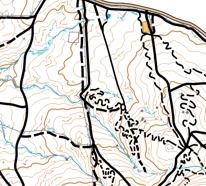



30 THE AUSTRALIAN ORIENTEER JUNE 2024


MTBO vs Foot-O What foot-orienteers
can learn from
mountain bike orienteering (MTBO)?


Specific MTBO skills that can help you improve your foot-O performance
One of the widespread myths is that foot orienteers can't learn anything new from mountain bike orienteering (MTBO). To debunk this myth, we focus on ten key aspects of MTBO that can help improve your foot orienteering (FootO) skills, some of which you may not have considered before.
1. Route choice
One critical skill that MTBO develops is the ability to confidently and quickly choose the best route. MTBOers analyse larger portions of the map to make optimal choices, often dealing with ‘backwards’ route choices (starting by going in the opposite direction) that may in fact be faster despite a longer distance. Riders learn to faster choose among equally good route options that must be considered when finding the optimal route.
2. Faster decision making
Everything happens faster when you're riding a bike. At complex junctions, you might have only a few milliseconds to make the right turn at high speeds. MTBOers learn to think faster, doubt less, be more decisive, and make confident decisions quickly. The price for slow decision making is much higher than in foot-O. So MTBOers are fast decision makers.
3. Improved memory
In MTBO, riders have limited time to read the map, they can read the map predominately on flat or gentle uphill terrain, but cannot read the map
downhill, on single tracks, or steep uphills. This forces riders to memorise the map, their future actions, and decisions, hence improving their memory skills and confidence in their reliance on memory.
4. Cost of mistakes
Mistakes in MTBO are more costly due to higher speeds, due to the rules that require staying on roads, and the discrete nature of decision making. If you make a wrong turn, you can't simply correct yourself by riding through the bush; you have to return and take the correct turn. MTBOers are acutely aware of the cost of mistakes and have advanced control mechanisms.
5.
Cost of stops
While an additional micro-stop might go unnoticed in elite Foot-O, even a brief stop while riding at 25-30 km/h means a loss of speed, wasted energy, and time to regain speed. What might be a 2-s loss for a foot orienteer could turn into a 10-15-s loss (and energy loss) for an MTBOer for a similar map check or details check.
6. Endurance and physical strength
MTBO events are typically longer compared to Foot-O events. A long championship course at the World MTBO Championship could easily be 40 km for men elite, requiring 110-120 min of top-level endurance, physical strength, and concentration. Elite MTBOers are undoubtedly strong.
7. Equipment optimisation
The bike's role in MTBO is almost as crucial as a horse in horse racing. While a foot orienteer can continue the race if
the compass fails or the shoe is damaged, the race is over if the bike fails. This teaches MTBOers to take extra care of their bikes and know their equipment well.
8. Diversity in training
While some people are destined to practice running for the entire life, the majority of people would just enjoy more diversity. Even if you don’t care much about all important issues above, just bringing more diversity into your routine could help increase training hours, improve motivation by learning new exciting skills.
9. Substitute training during running injuries
Riding can serve as a substitute during running downtime or injuries. Most running injuries allow biking exercises first, helping maintain physical shape, to engage in orienteering events, maintain navigational skills and map reading, and enjoy the competitive and social aspects of the sport.
10. Exploration of terrain
MTBO events allow you to see and enjoy more of the area, bush, and terrain compared to Foot-O events. While a local Foot-O event might cover a 1 km² area, a local MTBO event requires at least a 2 km² area, with state championships often covering 5-10 km² MTBO events often offer spectacular views, diverse landscapes, and the enjoyment of wildlife.
By considering these aspects of MTBO, foot orienteers can enhance their skills and performance in Foot-O. There is indeed something to learn from mountain bike orienteering☺!
JUNE 2024 THE AUSTRALIAN ORIENTEER 31
MTBO: WMMTBOC 2018, W40, two gold & two bronze. FOOT-O: JWOC 1998 (14); WOC 2001 (28 & 41); Silva Medal 2020 and 2021.

MTBO training camp
MAYA BENNETTE (VICTORIA)

Afour-day training camp organised by Kay Haarsma and run by a past Czech MTBO world champion Veronika Kubinovawas held in Ballarat over the Victorian school holidays. The camp began on Thursday with a corridor exercise, then a full SI Air middle-course riding in Woowookarung State Park and the surrounding suburbs, before doing pairs’ navigation-training exercise and a MTBO Park-StreetO that night.
On Friday morning we focused on the 'Traffic Lights' method. The night before we went through the map for the next day and highlighted each part of our route either green, yellow, or red based on how much focus on navigation it needs compared to focus on riding. Green represents very little map reading, with most concentration on speed and riding; yellow a 50-50 split; and red for complex areas where almost all focus would be on navigation.
After lunch we did two more exercises, the first was redrawing. For this Veronika taped up the map 100 m from us and we would have to run back and forth to redraw the map ourselves. We could draw/write whatever detail on the map we liked. Some people re-drew only the important paths, some wrote step-by-step instructions such as ‘second left, first right,
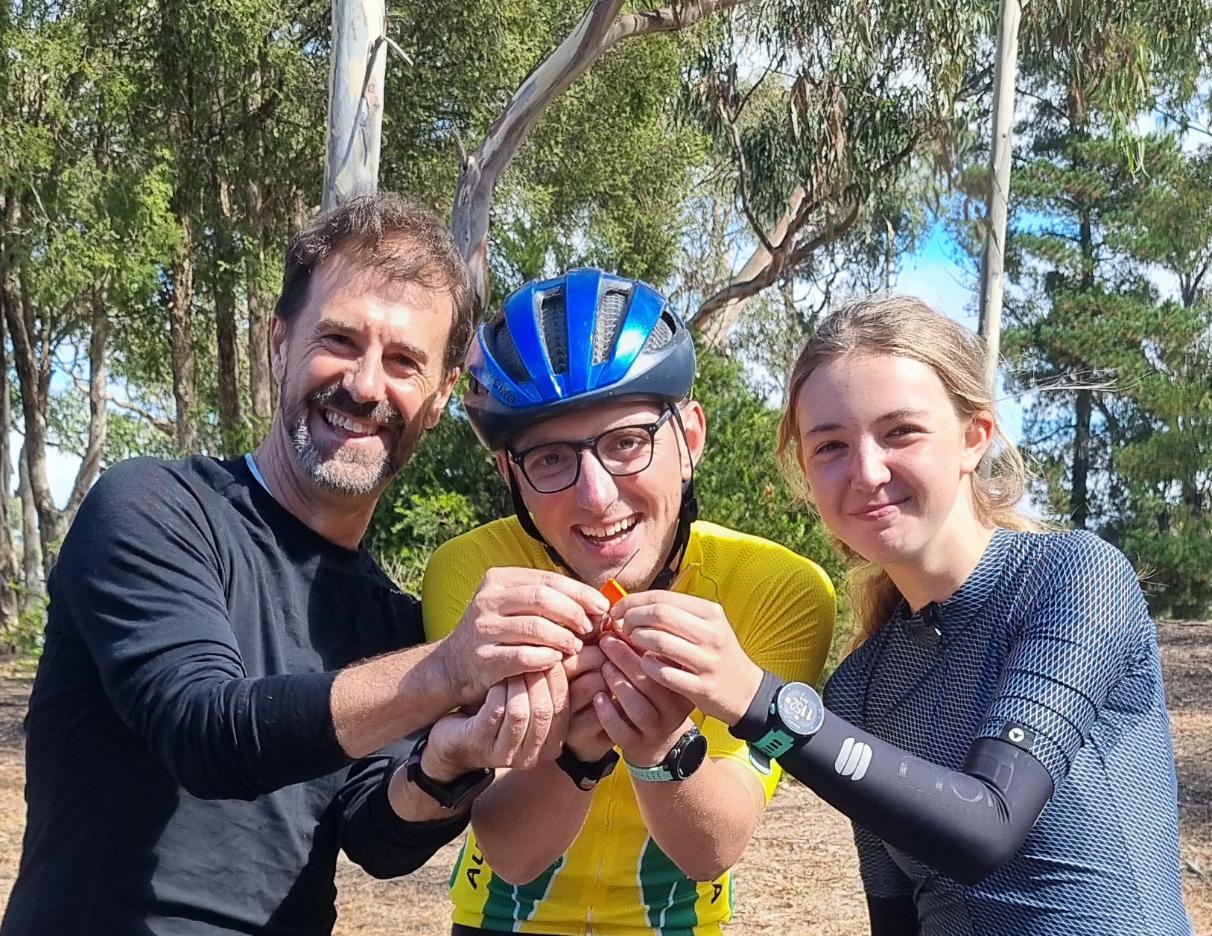
etc’, while some included lots of detail on other features such as contours and creeks. It was really interesting to see what different people use to navigate. We then had to ride the course using the maps we had just drawn.
The second activity was quite similar, except you had to memorise the route to the next control before riding it, and didn’t have any sort of map during a leg. At each control there would be a map of the next two controls, and you would have to memorise your route to the next control or the next two, before going out to ride it with no map. As the course went on the distances between controls got longer making it harder to remember.
On Saturday we did five mini-mass-start races at Creswick working our way north across the map. Each map had multiple forkings to practise focusing on your own race and not getting distracted around other people, which was something a lot of us had struggled with earlier in the camp. The first mass start reflected this with almost everyone getting lost, going the wrong way or to someone else’s control. But it was clear we all were improving riding around others the more mass starts we did.
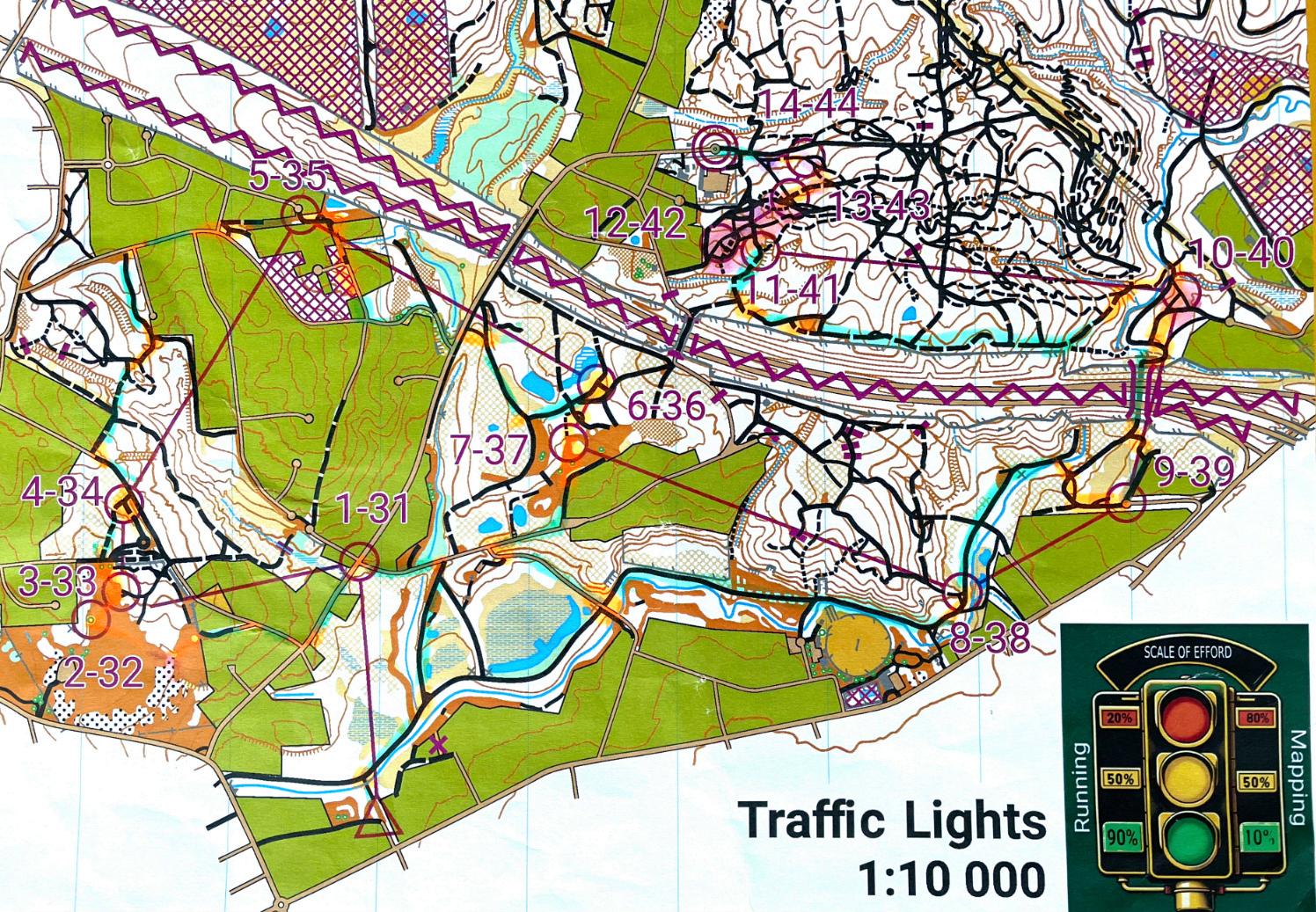


32 THE AUSTRALIAN ORIENTEER JUNE 2024
Contours only map.
The relay winning team of Ben, Will and Maya. Photo by Kay Haarsma.
MTBO TRAINING CAMP
Ariadna Iskhakova. Photo by Kay Haarsma.
On the way back we did a Combotech map which included three different navigation techniques representing different ways people navigate.
The first was just the contours. There were no paths on this map, and you had to compare the contours on the map to what you could see in real life in order to determine which direction to go or what path to take. You could also use other features like earth banks and erosion gullies. Compass reading was also quite helpful. This exercise was a really good practise at reading contours, which is something that can be overlooked in MTBO.
We then did a ‘Squarrows’ (Squares and Arrows) map. In this exercise there would only be small squares of the map visible with arrows showing which direction you would come from and leave each square. You would then have to continue straight between each square until you were in the next one. This represented only navigating at junctions and felt quite similar to the traffic-light exercise as you would go full pace with little to no navigation between squares, and only focus on navigation at the junction slowing to either orange or red depending on the complexity of the navigation.


The third technique was just using paths. On this map we had no contours or track grading, meaning that apart from counting junctions and roads it was very hard to keep track of where you were or if you were going the right way. Therefore, we also used the distance between junctions or bends and the compass to double check.


On Sunday we did a fun relay in South Woowookarung to practise what we had learnt over the last four days. We also did a relocation exercise on the way back. For this we would flip our maps over so we couldn’t see them and then Veronika would ride around in random directions (often in circles) and
then make us figure out where we were and navigate to the next control. This was a helpful exercise both for memory as well as learning to use your surroundings to relocate yourself after having gone the wrong way.
Thank you so much to Veronika for running all the trainings and sharing her knowledge and experience with all of us.The training camp was a great opportunity to improve and we all really appreciate it. And thank you so much Kay for organising the training camp, and Veronika and Jiri who put out over 100 controls over the four days.

Kay Haarsma (SA) Huge thanks to Czech coaches Veronika and Jiri for a truly awesome camp. I had asked for a busy program, and that’s what we got. Navigation exercises to and from the maps; discussions over lunch each day in the forest, and evening reviews. They put out approximately 160 controls/tapes, produced 26 maps; had two exercises with full SI AIR; for over 100 km of courses! No wonder the younger ones were tired! The camp had small numbers but representatives from five different states, so many useful techniques should be fed back.SA’s Jack Allison even attended a week before his marriage! I learnt why the Czech team play card games in WOC quarantine! Thanks also to the Eureka club for including MTBO in their street event, hosting Veronika and Jiri beforehand, and for use of their maps and equipment.
Ariadna Iskhakova (ACT) I really loved this camp, because I got to meet many new people, as well as world champions, and enjoy four days of training with them. Our exercises were very interesting and complicated, and I will definitely remember this super fun experience! One of my favourite exercises was drawingyour own map from memory and then navigating with that map. It was tricky, but I made it!
MarcusCazzolato (SA) I highly enjoyed all the fun and wellset trainings, including the mass starts, relays, and trying to wrap my head around the corridor and square maps. I also found it really interesting to listen to and have our rides analysed by Veronika and Jiri. I learnt a lot about MTBO, including things like route choice, flow, and dealing with mistakes.
Marina Iskhakova (ACT) I was blown away by the diversity of activities, variety of shared MTBO-training techniques, incredible passion for MTBO and awesome professionalism in everything Veronika and Jiri did. They put the same amount of energy and thoughts into each training, as if it was a World Cup Model training week. Thanks Kay for organising this.
JUNE 2024 THE AUSTRALIAN ORIENTEER 33
Organiser
Squarrows.
Jiri, Kay and Veronika.
The greatest Australian orienteer of all time competing in Australia
RICHARD PATTISON, BENNELONG NORTHSIDE, NSW.
In the summer 1996 issue of The Australian Orienteer magazine, Louise Fairfax declared Rob Vincent to be the greatest Australian orienteer of the first 25-years of the sport, closely followed by Carolyn Hooper/Jackson. Fast-forward another 25 years, let’s review and reveal the next generation of athletes to be compared against Rob Vincent and Carolyn Jackson.
Louise Fairfax applied a robust straightforward algorithm –points were assigned for high placings (first place = 5 points, second = 4, third = 3, fourth = 2, fifth = 1) in a perpetual prominent competition (Australian Long Distance Championships in senior elite) allowing different eras to be compared. The results were limited to Australian residents only, neutralising the strong overseas contingent in some years. This article focuses on foot orienteering, because hey… in MTBO there is no discussion, Adrian Jackson = five world championships.
The Louise Fairfax Algorithm (Australian Long Distance Championships)
Based on the ‘Louise Fairfax’ algorithm, Jo Allison is the greatest Australian orienteer (competing in Australia) of all time (four times winner, twice second, five times third, three times fourth, once fifth, so 4-2-5-3-1), overtaking Rob Vincent (4-2-1-30) and scoring equal points with Nicki Taws (4-6-2-0-0), but Jo is just ahead based on top-5 placings. Natasha Key has won the most Australian Long Distance Championships in history but is ranked third in this algorithm (6-2-1-2-3). Tash just needs one more at least fourth place to overtake Jo to be considered Australia’s greatest – had Tash competed in the elite class last year in WA then a fourth place, after course completion, was guaranteed given only three Australian women competed in W21E. Simon Uppill (4-4-0-2-0) is the greatest male orienteer of

all time, having overtaken Rob Vincent in 2019 by winning the Australian Long Distance Championships. It is worth noting the current generation lost two opportunities to score points due to COVID cancelling the Australian Championships in 2020 and 2021.
A few prominent names are missing from the 15 below e.g. Hanny Allston has 20 points, achieved by winning all four Australian Long Distance Championships entered, 100% win record, yet in a way that proves the algorithm – the greatest of all time requires an element of longevity, Jo Allison’s 15 top-5 placings is more of an all-time achievement than can be recorded in four appearances. Hanny’s omission proves another point that Louise Fairfax acknowledged in 1996 – this algorithm is a domestic listing, with no consideration to performance on the international stage e.g. Hanny’s World Orienteering Championship (WOC) gold in the 2006 Sprint, Australia’s only gold at WOC.
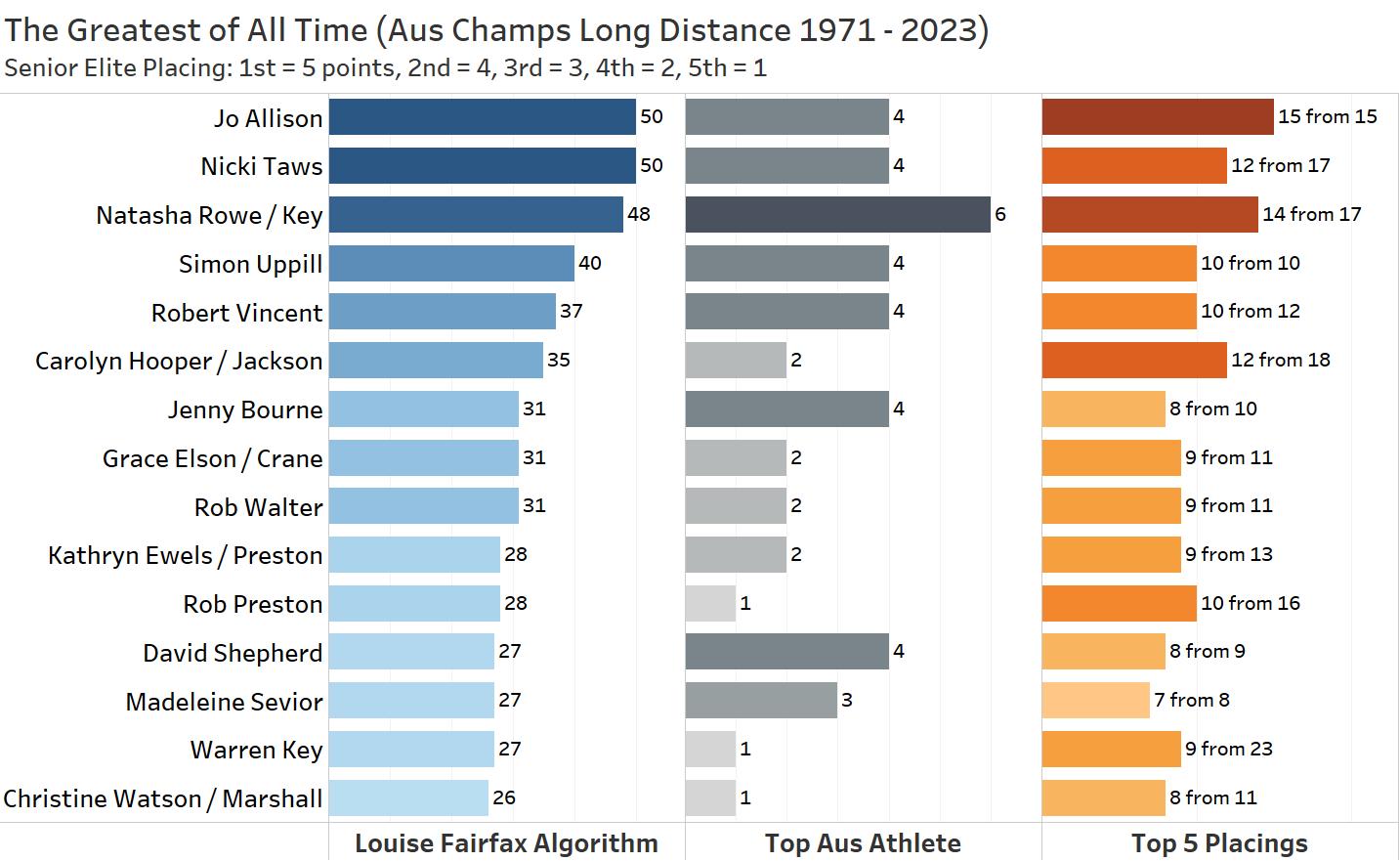
34 THE AUSTRALIAN ORIENTEER JUNE 2024
BEST ORIENTEER
Jo Allison and Nicki Taws. Front cover of The Australian Orienteer.
Perhaps the algorithm can be expanded to cover more formats/ carnivals? Most orienteers would feel more comfortable in the declaration of 'The Greatest of All Time (GOAT)’ based on a larger sample of results. However, the Australian Orienteering Middle Distance Championships (started 1992) and the Australian Sprint Orienteering Championships (started 2004) cannot be included without disadvantaging earlier generations. The same likely applies for international results given international travel was not as easy and events not as frequent. Therefore, the only valid inclusion of a major event is the Australian 3-Days that started in 1974, which has a slight disadvantage to some eras with no events 1971-4 plus the recent COVID disruptions (no Australian 3-Days in 2020, and no Australian Long Distance Championships in 2020 or 2021). Another aspect of the algorithm worth considering is the point weighting. As an example, Rob Preston is ranked 11 greatest orienteer of all time. Rob’s career statistics are impressive, ten times top-5 placings is a fantastic achievement, but Rob has not won a championship, a top Australian athlete once beaten by Rune Olsen, but no championship. When considering the greatest of all time, I think the greatest athlete must have won multiple championships, a large number of runners-up and placings is not enough. Therefore, a possible adjustment to the algorithm is a greater point weighting for the champion, and/or, points only awarded for a top-3 finish rather than top-5.
The expanded algorithm (Australian Long Distance + Australian 3-Days, top-3 placings)
Based on an expanded algorithm of the Australian Orienteering Long Distance Championships plus the Australian 3-Days, and, tightening the point scoring to top-3 placings (first = 3 points, second = 2, third = 1), then… Nicki Taws is the greatest Australian orienteer of all time. Nicki competed 28 times in the Australian Long Distance Orienteering Championships or Australian 3-Days, achieving eight wins and 12 runners-up, plus was third twice. Nicki placed in the top-3 a total of 22 times spanning 16 years (1988-2004), achieving the podium in 14 of those 16 years, now that truly is longevity and greatness. In comparison, Jo Allison (The GOAT using the Louise Fairfax algorithm) has 10 wins, four runners-up and seven third-place finishes. Nicki’s record of 8-12-2 likely a greater achievement than Jo’s 10-4-7, Nicki has two fewer wins, but eight more
runners-up. With this revised algorithm, Simon Uppill moves up to the second greatest of all time, with ten wins and nine runners-up. This is an interesting conundrum to ponder, which of these records is better: Nicki’s 8-12-2, Simon’s 10-9-0, Jo’s 10-4-7, or Tash’s 10-7-1? These four athletes clearly stand-out as the four greatest Australian orienteers of all-time. With this version of point scoring, Hanny Allston moves up to seventh greatest of all time. Following the Australian 3-Days 2024 in SA, the key mover is Grace Crane (W21E champion) moving-up two places into sixth greatest of all-time, and now just a runner-up finish away from fifth overall. The other changes from the recent competition: Vanessa Round (third) moves into 25th on 24 points, Brodie Nankervis (runner-up) moves into 30th on 13 points, Alastair George (winner) moves into joint-58th on 5 points, Emily Sorensen (runner-up) moves into joint-88th with 3 points, and Ewan Shingler (third) gains his first point entering at joint-123rd.
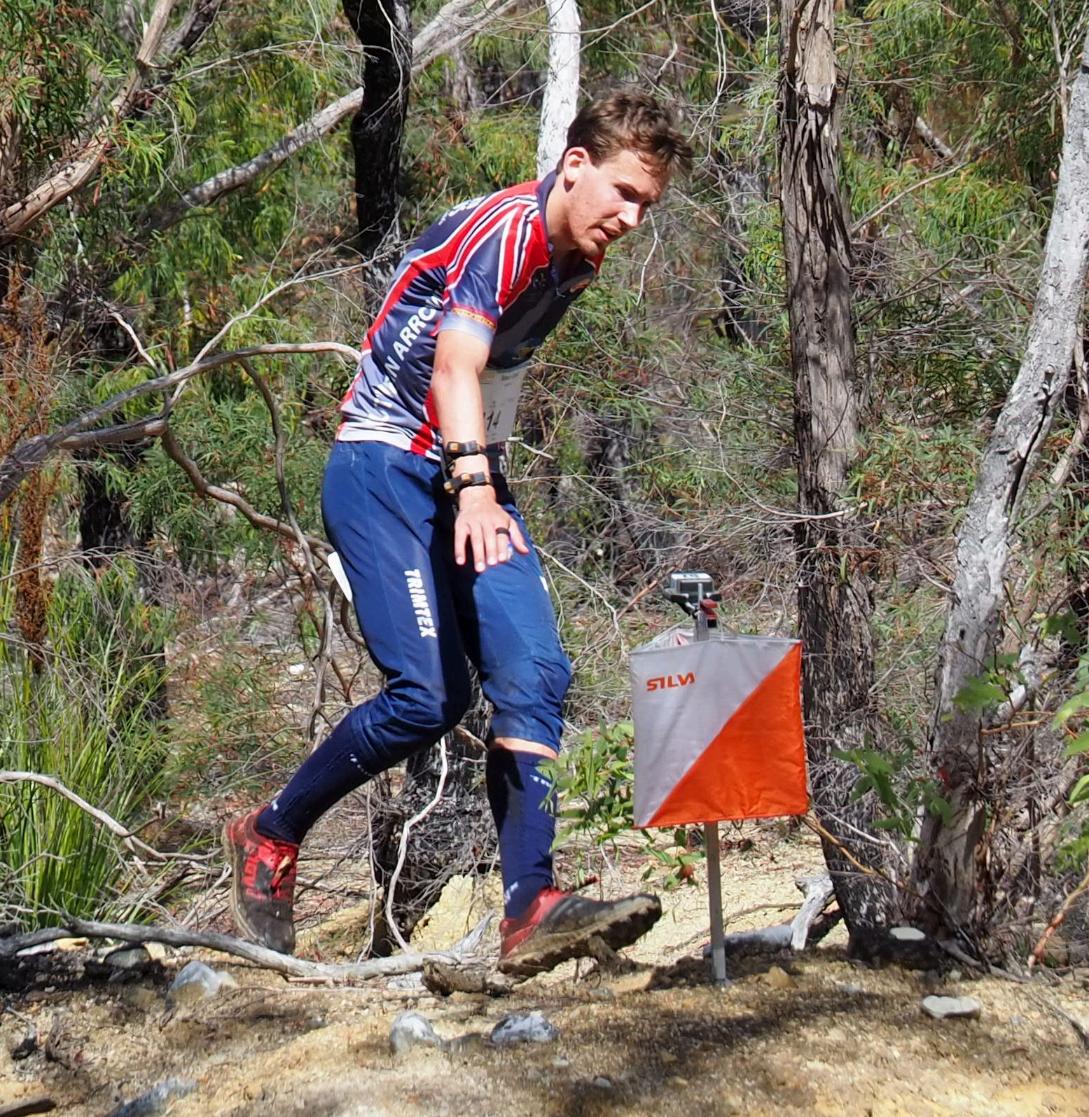

Other point-scoring options were explored to understand if the rankings would change substantially. Nicki Taws was ranked #1 with the 3-2-1 score for top-3 placings (3 points for the first place, 2 for second, and 1 for third), with the 7-5-3-2-1 score for top-5 placings, and with the 5-3-1 score for top-3 placings. In comparison, Jo Allison ranked first on 95 points ahead of Nikki Taws’ 94 points when Louise Fairfax’s original 54-3-2-1 score for top-5 placings was used, with Simon Uppill on 92 points and Tash Key on 91 points.
JUNE 2024 THE AUSTRALIAN ORIENTEER 35
Simon Uppill. Photo by Peter Yeates.

All formats
The final task, is to review the greatest of all time within each format, as a result, earlier generations are not considered in the middle and sprint distance. This chart uses the Louise Fairfax algorithm (top-5 scoring) to provide consistency across formats to the original ratings. The key message from this chart is Simon Uppill’s dominance across the formats. Simon is the greatest of all time in three formats, it’s only in the long distance where Simon has not achieved the GOAT status – that format was the original focus of this article, had the coverage not been expanded further, then Simon’s dominance over his generation would not have been revealed.
As with every ‘greatest of all-time’ debate, e.g. Bradman vs. Lara vs. Tendulkar, or, Margaret Court vs. Steffi Graf vs. Serena Williams, the fun is perhaps more in the discussion and reliving memories than in the final declaration. I hope this article provides inspiration and aspiration for current and future athletes to strive for their inclusion in this debate.
The Australian Championships results can be analysed online via several pages/visualisations: https://public.tableau.com/ views/AustralianOrienteeringChampionships-FullHistory/ RunnerHistory-Grid
Methodology:
The Australian Long Distance Championships results were sourced from OA: 1971–2017 compiled by Blair Trewin and team in a CSV file on the OA website, 2018 onwards from Eventor. The Australian 3-Days results were from a mixture of sources: 1974-2006 from Soicialfx (Jono McComb?), the top-5 placings were provided by David Hogg for the missing years (1974, 1976, 1977, 1978, 1981, 1988, 1991, 2004), 2007-2013 from the wayback machine of OA and state association websites, 2014 onwards from Eventor.
The classes selected for the analysis were 21E when available, otherwise 21A, and then 19E & 19A for the Australian 3-Days in the 1970s.
The names from results were manually merged to consolidate results for individuals e.g. Dave Shepherd and David Shepherd have both won multiple championships, and, females with multiple family names were merged where known e.g. Natasha Rowe and Natasha Key.
The most challenging aspect of the analysis was determining who should be considered as an Australian orienteer, given that I don’t know 90% of the people in the results. My guideline
was to consider athletes with an OA club membership, or no club, given that overseas athletes typically have their country in the results. That seemed to work, until a number of overseas coaches-in-residence were noted with OA club membership e.g. Rune Olsen and Ralph Street. They were manually omitted from the results. Then in reverse, some overseas athlete results were included e.g. Grant Bluett and Julian Dent with their Swedish clubs. Finally, other athletes were determined on a case-by-case basis: the great Kiwi Lizzie Ingham won multiple championships with Canberra Cockatoos and Abominable OMen so possibly those events should be considered, however, I’m sure Lizzie would never consider herself an Australian orienteer, so Lizzie is excluded from the analysis. Then again another reverse situation, Matt Crane won multiple championships as an overseas athlete, ultimately Matt has chosen to call Australia home so all of Matt’s results are now considered in his career totals. The classification of Australian athletes is important, because when an athlete is excluded as an overseas competitor, an extra point is allocated to a number of other athletes in their career totals.



36 THE AUSTRALIAN ORIENTEER JUNE 2024
BEST ORIENTEER
Natasha Key and Jo Allison.
Liz Leung is the new Communications and Marketing Manager of Orienteering Australia
Liz has been orienteering since March 2023 and is a member of the Illawarra Kareelah Orienteers. Outside of orienteering, she enjoys snorkelling and playing futsal. Fun fact: Liz is American and was born in New Jersey. She’s lived in Sydney now for over four and a half years.
In this role, she is most looking forward to blending her professional experience in marketing and personal enjoyment of orienteering into an impactful social media and communications strategy.
Hania Lada talking with Liz Leung
Hania:Hi Liz, welcome onboard. Congratulations on your new role with Orienteering Australia. How did you discover orienteering?
Liz: Thanks for the warm welcome! I’ve been orienteering for a little less than a year. My partner grew up orienteering in Canberra with his family so naturally when he went to orienteering competitions, he would always invite me and the sport definitely piqued my interest. I grew up in America and never heard of orienteering before I came to Australia but the past year has been a blast learning how to navigate around the bush and I’ve enjoyed travelling to parts of Australia for orienteering competitions I likely never would have gone to!
H: Yes, visiting different places in the country for orienteering is awesome. Where have you participated in orienteering?
Liz: I’ve been to local events mainly around Sydney and Canberra. Last year I attended a few state league events like the Queen’s birthday (now King’s birthday) long weekend in Newcastle and the long and middle distance orienteering championships. Over Easter 2023, I participated in the national three day orienteering championship. And I’ve joined the Illawarra Kareelah Orienteers Club.
H: It sounds like you have already experienced a fair amount of orienteering, in less than a year! How has your orienteering journey been since your first event?
Liz: My orienteering journey started like many kids’ do: walking the courses, learning how to read the map and doing some easy courses to get the hang of things. At first, it was definitely a bit overwhelming. But the community that
orienteering fosters is one that is highly encouraging and accepting of new members. Everyone has been so supportive in answering all my ‘beginner’ questions and providing really helpful advice for future races. I’ve worked my way up to moderate courses and while I still have a way to go, I’m very glad to have started orienteering. It’s definitely a sport you can do for the rest of your life. H: Oh yes, many of us are hooked for life, and there are so many different events and formats to try. What type of orienteering is your favourite?
Liz: My favourite type of orienteering is definitely sprint orienteering. I love how fast paced and exciting the courses are. It’s definitely an adrenaline rush. I would definitely say I’m the best at sprint orienteering too since my navigation skills are still growing - although you’d probably know that if you looked at my splits.

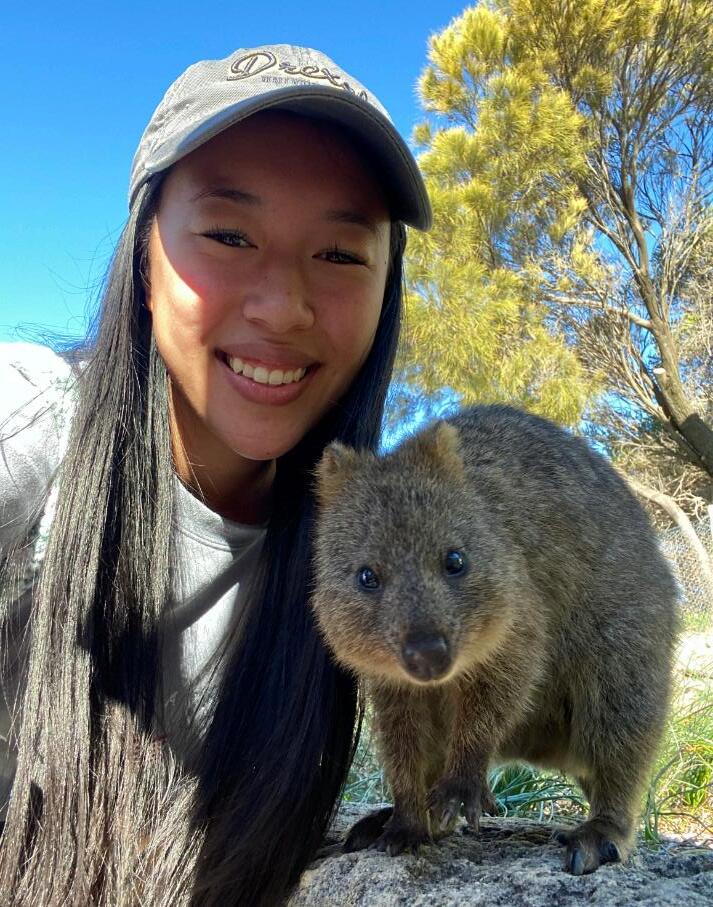
H: I think with orienteering we all keep learning regardless of how experienced we are. What are your plans for your new role as the marketing and communications manager?
Liz: For the first few months of my role as the marketing and communications manager, my focus will be on analysing our current communications and marketing strategy to see what’s working and what needs improvement. The end goal is to create and execute a strategy across all our platforms that allows Orienteering Australia to reach a wider audience across Australia and hopefully bring more people into the wonderful world of orienteering.
H: What can we do better to popularise the sport?
Liz: As someone who is relatively new to orienteering, I think I bring a unique perspective to how we can popularise the sport. While growing a tight knit community is important, there are many parts of Australia where orienteering is yet to reach or just not as well known compared to other sports. Finding an intersection of people who have similar interests to orienteering could be a great bridge for new members. People who are part of outdoors clubs or bouldering gyms would likely enjoy the idea of a sport that is a physical and mental challenge. Putting orienteering on more people’s radar will be a strong step in growing the community and once people get involved once, I’m sure they’ll be back for more.
JUNE 2024 THE AUSTRALIAN ORIENTEER 37
Liz Leung after one of her first orienteering events. Photo by Ewan Barnett.
OA NEWS
Liz Leung with a quokka on Rottnest Island. Photo by Liz Leung.
Team for Junior World Orienteering Championships 2024
Orienteering Australia is pleased to announce the team for the Junior World Championship to be held in Plzen, Czechia from June 30-July 7 2024.
Australia has a unique and outstanding history of participation and success at JWOC and we have no doubt this year’s
MEN: Alvin Craig, Cooper Horley, Oskar Mella, Owen Radajewski, Callum White, Sam Woolford
Reserves: Euan Best, Jamie Woolford
WOMEN: Zoe Carter, Erika Enderby, Mikaela Gray, Milla Key, Natalie Miller, Nea Shingler
Reserves: Justine Hobson, Sophie Taverna
JWOC Team Leaders: Warren Key, Serena Doyle and Brett Weihart.
team will continue that great tradition. The Junior World Championships is a great opportunity to demonstrate abilities at the highest level and a major step on the pathway to senior competition.
Selection of the team was once again very closely fought and congratulations








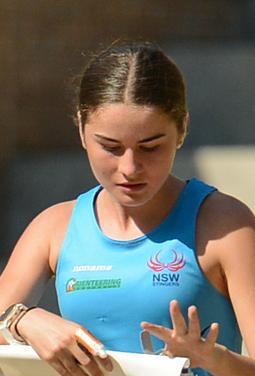



Team for World MTBO Championships
Following the recent selection trial at Bostock in Victoria, Maya Bennette (junior women) and Lucas Kent (junior men) from Victoria, and Will Whittington (elite men) from Tasmania have been selected to represent Australia at the World MTBO Championships to be held in Bulgaria in September. Congratulations to Maya, Lucas and Will.
to everyone who participated in the trial process. To those that were not selected, we look forward to supporting you in your endeavours to be part of an Australian National team in the future and remind you that you are an integral part of our sport.















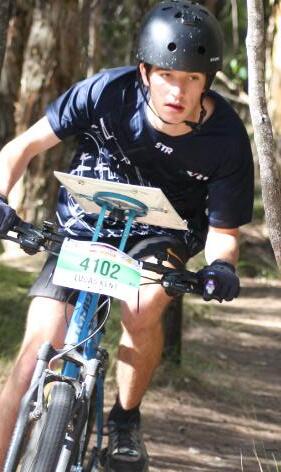


A reminder. The end of the financial year is approaching fast. Please consider making a tax deductible donation tosupport our teams representing Australia in2024. Thank you so much for your generous donations last year, they helped our athletes afford to compete overseas. The donation page on the Orienteering Australia website provides all the information about donations.

Link to the donation page https://orienteering.asn.au/donate/
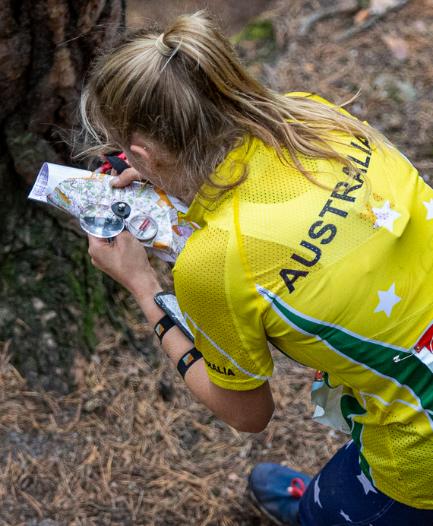



Team Leaders for World Championships
World Orienteering Championships – Natasha Key and Mary Fleming.
World University Orienteering Championships – Brodie Nankervis and Mary Fleming
World Mountain Bike Orienteering Championships –Kay Haarsma

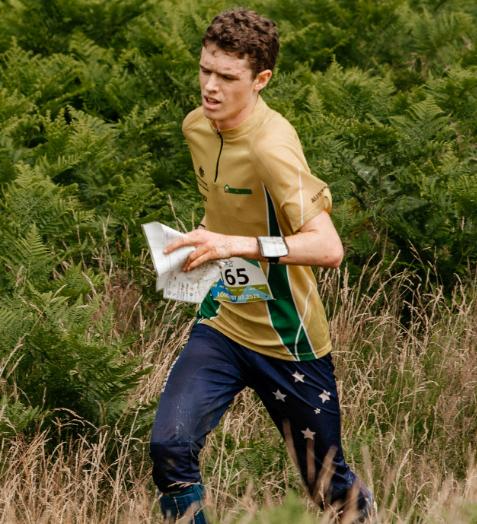



38 THE AUSTRALIAN ORIENTEER JUNE 2024 HIGH PERFORMANCE NEWS
Zoe Carter
Callum White
Cooper Horley
Alvin Craig
Erika Enderby
Oskar Mella
Milla Key
Mikaela Gray Nea Shingler
Natalie Miller
Maya Bennette
Sam Woolford
Owen Radajewski
Lucas Kent Will Whittington
Photos by quentinjlang.com
Photos from JWOC 2023 website
Photo:
Miroslav
Rygl
Photo:
John Harding
Photos: Tony Hill
Photo by
Tomá
Bubela


Teams for WOC and WUOC
The OA Senior Selection panel has selected the following teams for WOC and WUOC.
World Orienteering Championships, Scotland 12-16 July
Women: Mikayla Cooper, Erika Enderby, Milla Key, Nea Shingler, Caitlin Young Men: Cooper Horley, Aston Key, Henry McNulty, Brodie Nankervis, Ewan Shingler
World University Orienteering Championships, Bulgaria 1-5 August
Women: Zoe Carter, Mikayla Cooper, Natalie Miller, Nea Shingler, Emily Sorensen, Caitlin Young Reserve: Justine Hobson
Men: Alastair George, Angus Haines, Aston Key, Ewan Shingler, Leith Soden, David Stocks Reserve: Callum White
Extracts






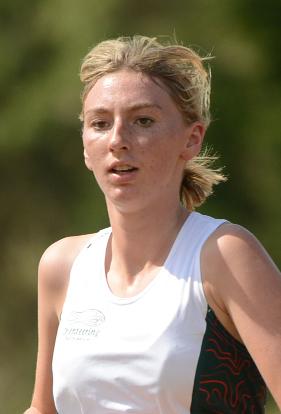








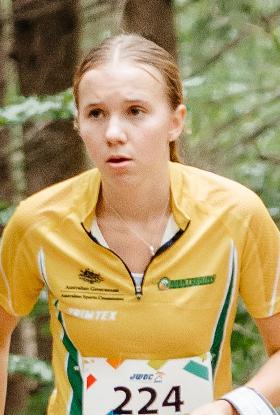

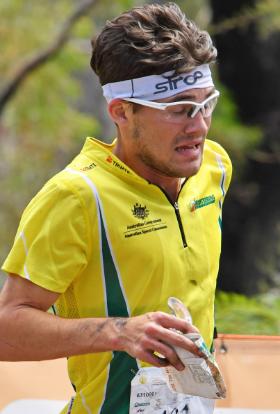




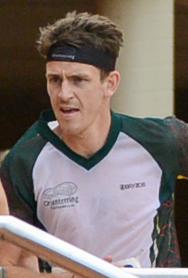
















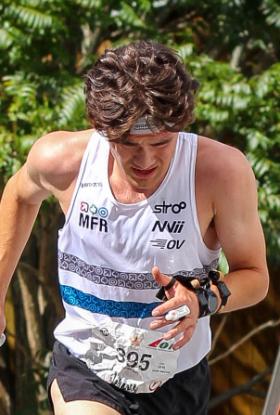













from Orienteering Australia Photography Policy. Operations Guide 6th Edition. Date Approved: 25 March 2024
5 Policy Guidelines and Procedures
5.2 The proliferation of cameras and recording devices means that there are few instances where a moment can’t be captured. An issue emerges however when photography occurs with no checks or balances on the activity, nor guidelines on usage. Additionally, for OA and its Members to truly seek to be inclusive to all persons, we also recognise there might be religious or cultural reasons why photography is not desired by some individuals. Hence, this policy seeks to control photography by a Relevant Person appointed by OA or its Members as an Authorised Photographer to ensure it is conducted in an appropriate, responsible, and ethical manner. It also guides how photographs shall be used by OA and its Members.
6 Authorised Photographer
6.6 Any Relevant Person capturing photography for purposes other than for private use at an orienteering event is strongly encouraged to gain accreditation as an Authorised Photographer.
7 Photography Capture Principles
7.2e. A person has the right to ask that any photographic imagery taken of them be removed from a communication channel of OA and its Members even if they had previously given permission and provided it is feasible to do so.




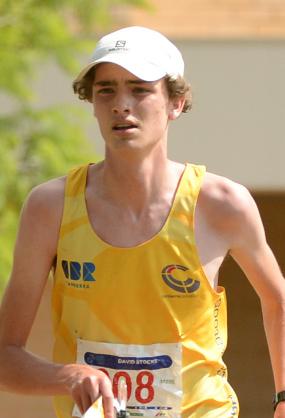


7.4f. Permission is required from adults to publish historical photos of them captured when they were a Child/Young Person.
8 Use and Distribution of Photographs in Communication Channels
8.2b. Images are not to be exhibited online or in publications of a Child/Young Person without parental knowledge and approval through a signed image consent form or equivalent such as email or SMS, and such images must be presented in a manner that de-identifies the Child/Young Person unless parental consent has been obtained for the full name to be published. Any caption or accompanying text may need to be checked so that it does not identify a Child/Young Person if such identification is potentially detrimental such as in the case of a Child/Young Person who is protected by a court order.
8.4 OA and its Members may use photographic imagery of a Child/Young Person taken in countries other than Australia in their communication channels provided that the principles of this policy are adhered to, particularly that consent has been provided for any photographs of a Child/Young Person.
8.5 In the use of any photographic imagery from an Authorised Photographer or otherwise, or from countries other than Australia, in any social media, websites, and other print and online materials shall include the name of the photographer.
JUNE 2024 THE AUSTRALIAN ORIENTEER 39
Zoe Carter
Alastair George Mikayla Cooper
Angus Haines
Natalie Miller
Aston Key Nea Shingler
Ewan Shingler
Emily Sorensen
Leith Soden
Caitlin Young
David Stocks
Mikayla Cooper
Cooper Horley
Erika Enderby
Aston Key Milla Key
Henry McNulty Nea Shingler Brodie Nankervis
Caitlin Young Ewan Shingler
Photo by Tony Hill
Photo from JWOC2023 website
Photo: quentinjlang.com
Photo by quentinjlang.com
Photo by Tony Hill
Photo by Petr Hap
Photo from JWOC2023 website
Photo by quentinjlang.com
Photo from JWOC2023 website
Photo by Evalin Brautigam
Photo from JWOC2023 website
Photo by Terje W. Pettersen
Photo by Tomas Bubela
Photo by Natasha Key
Photo from JWOC2023 website
Photo by Tony Hill
Photo by quentinjlang.com
Photo by quentinjlang.com
Photo by quentinjlang.com
Photo by Tony Hill
Photo by Joolz Moore
Photo by Tony Hill
Australian orienteering websites

The Orienteering Australia’s new website has been launched. A link to The Australian Orienteer can be found at the top and the bottom of the home page on laptops, and if you scroll all the way down on mobile phones.



the magazine.

Most state orienteering associations also have links to the digital copies of The Australian Orienteer on their websites.



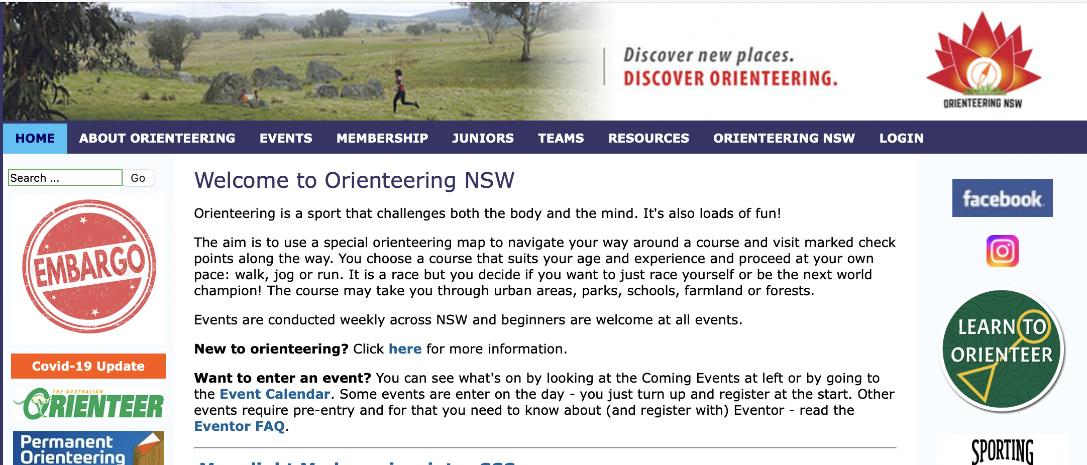
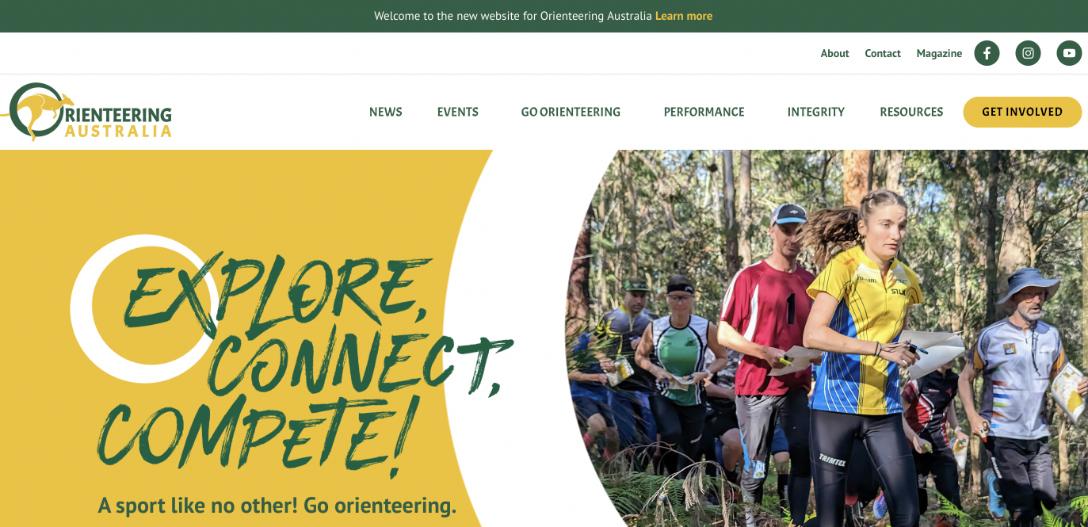



Letter to editor
Just reading the March mag online and your editorial. ONSW has this to assist landowners: Landholder-Brochure-2018.pdf (onsw.asn.au) Ian Jessup


40 THE AUSTRALIAN ORIENTEER JUNE 2024
Click on the three bars on a mobile phone. Find link to
Technology for orienteering: Games
Exploring the intriguing technology behind orienteering so you can use it too!
BY COACH TECH-O

There are times when sadness comes (…) you can’t go out orienteering! You might be between seasons, injured, have moved away from your club or can’t get out as often due to having a newborn (like my situation!).
Do not fear… online orienteering games are here.
I have reviewed (or should I say ‘have been playing’) some of the most popular games. You too can improve your orienteering skills, even if you can’t get into the outdoors.
Orienteering simulations
Catching Features is a popular orienteering simulation game where players navigate through virtual terrains using a map and compass. It offers realistic terrain and course layouts, challenging players' navigation skills in a competitive multiplayer environment. Players can enjoy it for learning, training or competing. Build up your points and your ranking; well done NZ for climbing to third! You will need to buy a licence for about $60 and download the program, but try the free demo version first.

If you want to quickly jump on the computer and try some virtual orienteering, The Forest – orienteering simulation gives you a great taste. Choose a novice to expert level course or try explorer mode for a treasure-hunt-style experience. Flipping between the map and scene gives you great visualisation practice; that is trying to see the shape of the land from the map and vice versa.
Route-choice games
Aston Key talked about Route Choice Game as great preparation for sprint orienteering. A leg between two controls is presented and you need to choose whether the left or right option is shorter. Challenge and excitement comes from racing the clock, reducing your error percentage and trying to get on the leaderboard.
RunningWild gets your adrenaline going as your little pacman runs along the route choice you draw on an orienteering course someone has uploaded, like the 2021 QLD NOL or Oceania Sprints uploaded recently! Your score is related to your time, so there’s pressure of identifying the shortest route and is good practice for actual racing. Compare your routes to others’ to refine your decision making. 3drerun.worldofo.com/2d/ runningwild.php
Control description games
If you like games with bells, popping confetti, timers and stars and diamond rewards, then Quiz | Orienteering race is for you. On this app, you’ll learn control descriptions and map symbols through themed levels, unlocking 218 symbols and collecting badges along the way. Also, try to compete against Coach TechO in the league quizzes! It makes learning easy, effective and fun. But in Australia we call some symbols by different names and earning a lot of diamonds can be difficult (you can purchase them to speed it up).
Maprunner also has a control description game. It doesn’t provide a rewarding gaming experience, but it uses a comprehensive list of descriptions.
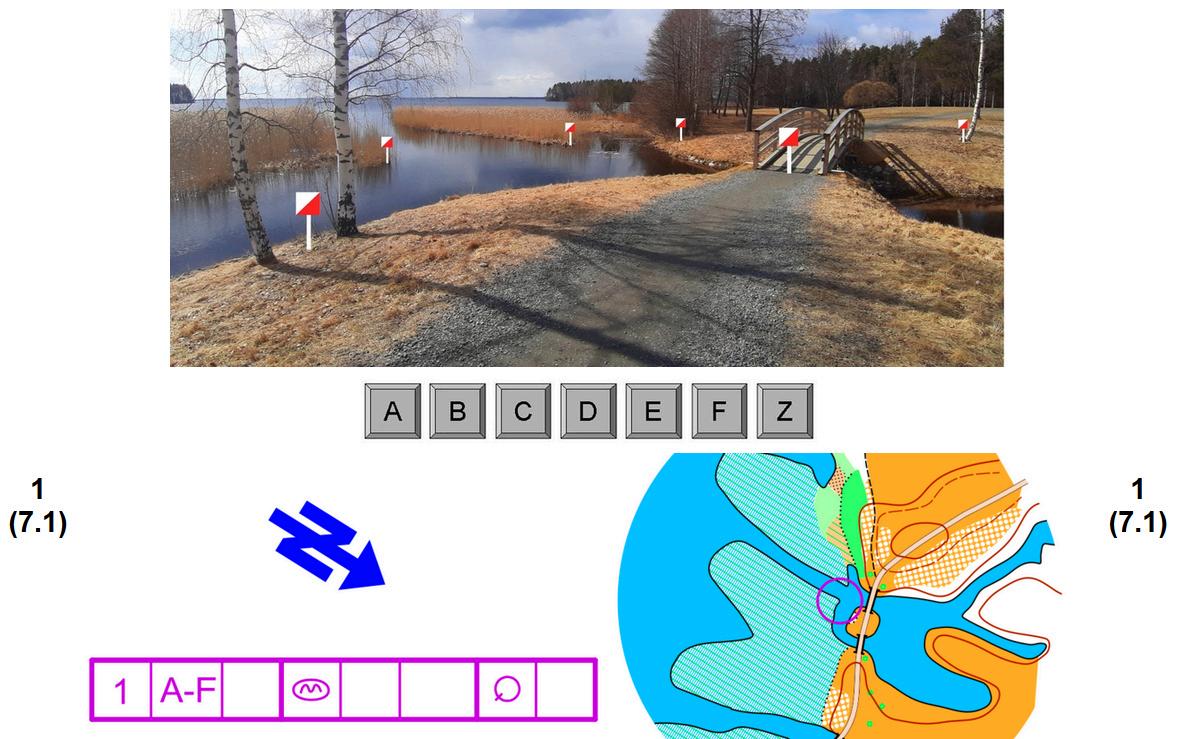
TempO simulator
Coach TechO would like to see more TrailO in Australia, but for now you can experience it online. After registering on TempO Simulator, practise and get the hang of it on the ‘Model station’. Then after some ‘Training courses’ you will be itching for more, and the competitions! It is a challenge to process all the information from the map, photo and control description when the timer is ticking.
Quizzes
As a final bonus, test yourself with Droobers online quizzes created by Octavian Droobers orienteering club. There are a series of quizzes to improve your technical skills and techniques; contours, orientating the map, map symbols, map memory, control descriptions.


Stay inside with a hot drink, get some armchair practice and when we get back into the outdoors we will blow everyone away with our new skills! Happy gaming!
JUNE 2024 THE AUSTRALIAN ORIENTEER 41 ORIENTEERING TECHNOLOGY
Orienteering Australia Awards
T
DAVID HOGG
he 2024 awards for services to Australian orienteering and inductions to the Orienteering Australia Hall of Fame were announced during the Australian 3-Days and presented to those recipients who were present. These awards are determined by the OA Awards Committee based on nominations received. Other awards presented at Easter were the 2023 Silva Medal (see December 2023 issue for full results) and the 2023 Athlete of the Year as determined by an Electoral College consisting of OFA officers involved with high performance.
In addition to the two inductees to the General Division of the Hall of Fame chosen by the Awards Committee, the OA Board made a special posthumous induction of Rob Plowright who passed away in Japan last year. There were no nominations for the Athlete Division of the Hall of Fame for 2024. Orienteering Australia congratulates all its annual award winners.
Orienteering Australia HALL of FAME
Hall of Fame – General Division
IAN BAKER (Vic)
Ian Baker’s most outstanding contribution to Australian orienteering has been the establishment of The Australian Orienteer as Australia’s national orienteering magazine. Having taken on the role of editor of The Victorian Orienteer in 1973, shortly after his introduction to orienteering, Ian saw the potential for expanding its scope as a national magazine.
From the mid-1970s, Ian worked to improve the quality of The Victorian Orienteer and began the tasks of convincing the Orienteering Federation of Australia (OFA) of the need for a national magazine and persuading the Victorian Orienteering Association to allow its newsletter to evolve into that role. Ian passionately pursued, and eventually gained, the support needed and the first issue of The Australian Orienteer appeared in June 1979.
To make The Australian Orienteer a truly national magazine, Ian encouraged contributions from throughout Australia and established editorial contacts in each state association. He also pursued and fostered contacts with overseas orienteering magazines.
Ian continued as editor until the end of 1985. The last of the 39 issues that he edited during that period was devoted to the 1985 World Championships in Bendigo, with colour pages appearing in the magazine for the first time.
After a break of 11 years, the position of editor became vacant and Ian returned to the task with renewed enthusiasm.
Coinciding with a new grant from the Australian Sports Commission to OFA to support the magazine, Ian worked with graphic designer, Peter Cusworth, to raise the professional quality of the magazine, improving its general presentation, and steadily increasing the proportion of colour pages. Ian retired for a second time in 2004, having edited a further 29 issues. With a professional background in marketing and public relations, Ian has been one of the main contributors over the years in seeking sponsorship and advertising to support Australian orienteering. In addition to pursuing advertising for the magazine, he was a member of the sponsorship committee for the 1985 World Championships and in 1997 was appointed to the position of OFA National Marketing Officer.
Ian also played a central role in the development and promotion of ski orienteering (SkiO) in Australia during the 1990s, when the International Orienteering Federation was actively seeking to have SkiO recognised as a Winter Olympic sport. This initiative required the sport to be formally established on at least four continents, with Australia seen as the fourth continent. Ian coordinated the Australian effort, particularly in


Victoria, and was appointed as Chair of the OFA SkiO Committee. He produced promotional material and, in collaboration with David Hogg and Terry O’Halloran in the ACT, instigated annual Australian Championships in SkiO. Australia’s support of the IOF’s ambitions was very much appreciated and acknowledged by the IOF.
As the founding president of Bayside Orienteers, which later merged with Red Kangaroos Orienteering Club to become Bayside Kangaroos, Ian has been one of Australia’s most active orienteers throughout most of the history of Australian orienteering, yet he never missed an opportunity to promote orienteering in all its disciplines at the local, state and national levels.
Hall of Fame – General Division
BOB ALLISON (ACT)
Bob Allison’s induction into the General Division of the Hall of Fame recognises more than four decades of service at the state, national and international levels in technical, mapping and administrative aspects of orienteering.
Bob’s involvement in orienteering began around the mid-1970s in Victoria with the Yarra Valley club, and continued when he moved to Canberra in late 1979, joining Canberra’s Red Kangaroos club (now known as Red Roos). After moving to Canberra, Bob soon became involved in mapping, both fieldwork and cartography, producing many hand-drawn maps between 1983 and 1993, and drawing Australia’s first OCAD
42 THE AUSTRALIAN ORIENTEER JUNE 2024
OA NEWS
Ian Baker (left) receives his award from Ron Frederick (OAM).
Photo by Sputnik. theawesomest.com
map, a revision of Tharwa Tor, in March 1994. This was the first of numerous OCAD maps which, in his role of ACT Mapping Officer, Bob maintained in a ‘library’ of ACT OCAD maps.
At the national level, Bob greatest contribution was on the technical side, being Chair of the OFA Technical Committee in 1990, 1991 and 1992, then in 1998, 1999 and 2000. He was elected OFA Vice President (Technical) in 2001 and Director (Technical) in 2002 and 2003, following a change in the OA Constitution. He was a course planner for the 1984 Australian Championships (Mount Clear) and controller for the 1989 and 2000 Australian 3-Days, the 2001 Australian Championships and the 2013 Australian Middle Distance Championships. He was the National Controller for World Cup events held in Ballarat in 1994 and in Canberra in 2000, and was one of the first Australians to be accredited as an IOF-licensed controller (now known as IOF Technical Adviser).
On the administrative side, Bob was ACTOA Treasurer from 1992 to 1994, then President from 1995 to 1997. He was appointed OFA Public Officer in 1995, holding that position until it was no longer required under the new (2022) OA Constitution. Bob’s contribution to orienteering has been recognised through being awarded the Mike Cassells Award for Services to ACT Orienteering in 1993, the Silva Award for Services to Orienteering in 1998, ACTOA life membership in 1999, and the Australian Sports Medal (ACT) in 2000.
Hall of Fame – General Division
ROB PLOWRIGHT (Vic)
Rob Plowright was a prolific mapper, well-respected course planner and event adviser, a former Australian representative and a JWOC/national junior squad coach who made significant contributions to Australian orienteering. He moved to Japan in 2000, where he continued to contribute to the international orienteering scene as a mapper, organiser and course planner before his untimely death in 2022 at the age of 59.
Rob began his mapping career in 1989 while still competing at the elite level. For much of his competitive orienteering career, Rob was based in Ballarat as a member of Eureka orienteering club, mapping the complex mining terrain that is a feature of the region, as well as many memorable granite maps. He later produced maps in Sweden, Italy, Japan, China and Canada. Many of his maps were used for national championships, World Cup and World Championship events.
Rob was one of the first Australians to use OCAD as a mapping tool, and was an early adopter of any technology that could improve the quality of maps, including LiDAR. He was known around the world as an insightful commentator on the technical aspects of orienteering through his contribution to many online forums.
Rob also made significant contributions to mountain bike orienteering, creating numerous MTBO maps in the Ballarat region, and introducing the use of dual scales on MTBO maps, with larger scales for detailed areas on a map insert to allow for more complex course

planning. In 1999, Rob completed a comprehensive survey of Victoria to identify the best terrain for MTBO maps.
Rob was an Australian national team member between 1983 and 1994. His first World Championships appearance was in 1985 at Mount Kooyoora in Victoria, when he finished 36th. Rob subsequently represented Australia at WOC in 1987, 1989 and 1991, in addition to several World Cups. His experience as a competitive orienteer gave him considerable insight into the unique requirements of high-speed navigation at the elite level. Rob also made considerable contributions to event management, both in Australia and in Japan, with over 25 years’ experience as a course planner and event organiser. He was the course planner for many major events, including the 1994 World Cup in Australia (middle and relay), the 2005 WOC Sprint in Japan, the 2005 Japan Championships (long), and the 2015 Australian Championships (long). At the local level, Rob was one of the chief organisers and instigators of the Eureka Challenge, a popular event held in the Ballarat region in the 1990s.

Rob also coached and inspired numerous juniors and young elite orienteers, in both Australia and Japan, including the Australian National Junior Squad in the early 1990s, and was JWOC coach in 1992.
In addition to his extraordinary legacy of maps, Rob made a lasting impact on our sport through his generosity, expertise and innovation in promoting and sharing the joy of orienteering, both in Australia and around the world.
JUNE 2024 THE AUSTRALIAN ORIENTEER 43
Bob Allison receives his award from an Awards Committee member Jenny Bourne. Photo by Frank Ingwersen.
Rob Plowright.
Other Awards
Silva Award for Services to Orienteering
PETER EFFENEY (QLD)
Peter Effeney has received the Silva Award for Services to Orienteering to recognise his development of the MapRun orienteering app which has revolutionised the organisation of events and training for many clubs in Australia and worldwide. MapRun greatly simplifies event organisation, and harnesses a familiar technology (smartphone) to attract newcomers into the sport, thus contributing to its growth. Peter first developed the MyOMaps app in 2014, which evolved into MapRun, released in 2016. MapRun uses GPSbased punching, that is, it uses satellite technology to locate controls, so that the orienteer’s smartphone or GPS watch beeps as they approach the control, and results and routes are automatically uploaded to the internet and immediately available. This means that there is no need to put out flags and punch units on
Silva Award for Services to Coaching
TONI BROWN (ACT)
Toni Brown has received the Silva Award for Services to Coaching for her work over 17 years in coaching juniors and women. Her contributions have included organising training camps in ACT and New South Wales for children, families and women, conduct of schools programs in the ACT and surrounding areas of New South Wales, coaching of the ACT Blue Lightning team at the Australian Schools Championships, and conduct of Level 0 coaching workshops. She initiated the ongoing SC-ORE school relay orienteering program in Canberra,

the course, saving a huge amount of time and effort for organisers of less formal events.
Peter has worked tirelessly and largely solo to develop all aspects of MapRun, from the initial concept, to coding and constantly refining the app, setting up the host server, establishing local administrators, developing and refining a website platform for administrator functions, and troubleshooting. He has sought feedback from local MapRun organisers and continues to add enhancements in response to their requests and suggestions.
MapRun enhancements have been supported by an Orienteering Australia grant and server costs are supported by donations from clubs that use the app regularly. Peter himself, however, has worked unpaid, donating a great deal of his time to this large-scale project. MapRun is now available in 10 languages, with local administrators managing events in 43 countries across all continents. Peter’s contribution has been recognised internationally. Together with UK MapRun promoter Pat
which introduced many children and their parents to orienteering and was involved in ACT activities for World Orienteering Day over several years. At the international level, she has developed and promoted junior development activities with New Zealand in association with the Australian or New Zealand Championships on many occasions between 2015 and 2023.
Toni has developed primary, secondary and outdoor education orienteering instruction programs, and prepared or contributed to a range of resource kits for school instruction. She has also been proactive in encouraging female orienteering participation in relation to some government and media initiatives.
David Hogg Medal for Services to Event Management
STEPHEN GOGGS (ACT)
Stephen Goggs has been awarded the David Hogg Medal for Services to Event Management in recognition of his leadership and management as the Carnival Director for the 2016 Easter Carnival, the 2019 Oceania and Australian Championships, and the 2023 Easter Carnival.
McLeod, Peter received the 2021 British Orienteering Award for Development and Innovation for his creation of MapRun. In March 2023 he was invited to present an IOF Global Development Webinar.


Having retired from full-time employment in mid-2015, Stephen offered to assist with carnival preparations for Easter 2016. His experience as a senior public servant saw him co-opted into the vacant role of carnival director, overseeing the coordination of the Prologue event at University of Canberra and the Australian 3-Days events at Canberra’s Isaacs Ridge and on private rural property in neighbouring NSW.
Preparations for Oceania 2019 began soon after Easter 2016, when it had already been decided that the carnival would be held in several locations
44 THE AUSTRALIAN ORIENTEER JUNE 2024
Peter Effeney. Photo by Sputnik. theawesomest.com
Toni Brown.
OA NEWS
Stephen Goggs receives his award from David Hogg. Photo by Susanne Harrysson.
beyond the borders of the ACT, with event locations in Cootamundra and Wagga Wagga in NSW, and Wangaratta and Beechworth in Victoria. Stephen coordinated a tri-state organising committee which delivered a sporting and financially successful carnival, with 1000+ competitors on the busiest day of the carnival.
Stephen again volunteered for the carnival director role for the Easter 2023 carnival, which took place mainly in the Snowy Monaro region south of Canberra, with the Prologue event moved into Canberra following a late change in landowner permissions.
At the local level, Stephen has coordinated the delivery of coaching to schools in the ACT and surrounding areas. Since 2016, primarily under Stephen’s leadership and coaching, Orienteering ACT has delivered schoolsbased coaching to 18,619 participants, with over 2000 hours of delivery and over 68,000 encounters.
Athlete of the Year 2023
BRODIE NANKERVIS
Brodie Nankervis is Orienteering Australia’s Athlete of the Year for 2023. In a year when there was no one standout competitor, he was a consistent performer throughout the season. The high point was at the World Championships where he was 34th in the long distance, the best Australian individual placing at WOC this year. He won the National Orienteering League final and was second overall over the season. He was also second in the long distance at the Oceania Championships and third in the other two individual events. Reflecting his consistency, he was the only athlete to get votes from every member of the selection panel. Aston Key and Henry McNulty were second and third in a very open field. Aston started the year with a clean sweep of the three Oceania Championships before injury brought his season to a premature end, while Henry got a pair of 35th places at WOC. Others to get votes were Vanessa Round, Nea Shingler, Patrick Jaffe and Maya Bennette.
Blair Trewin
Silva Medal Winner 2023 EUAN BEST
The 2023 Silva Medal has been won by Euan Best, M16, EV T on a count back having been one of a number of orienteers who attained maximum points from their best six designated events.
Congratulations Euan.
Darryl Erbacher

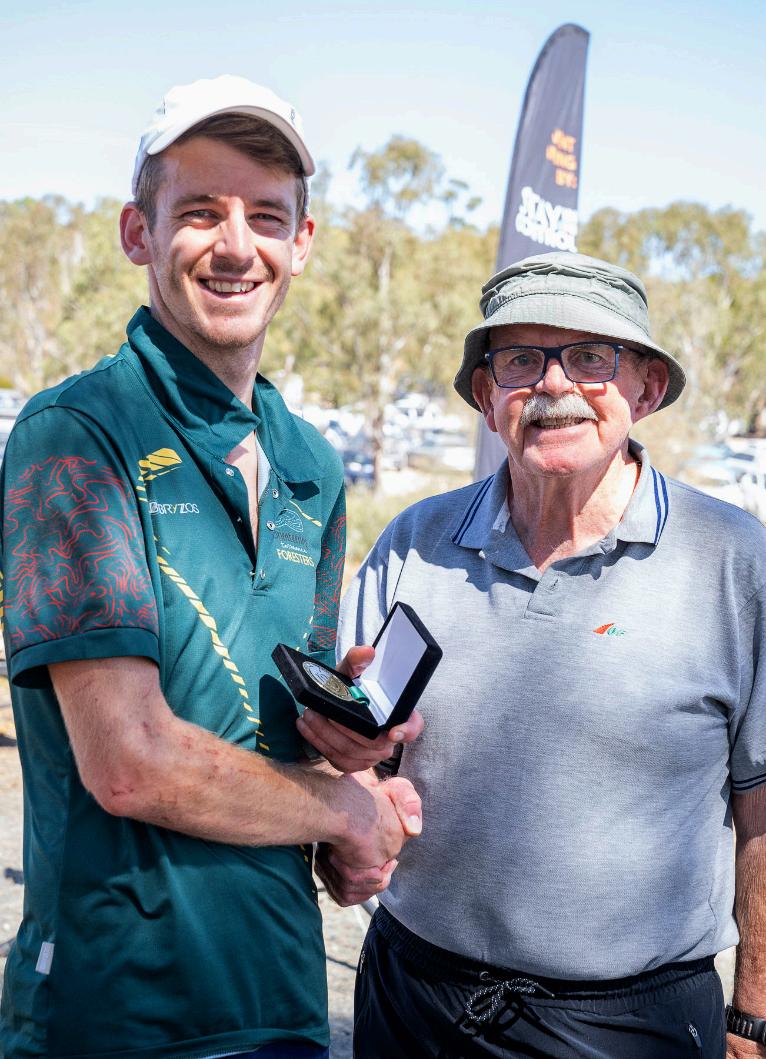


JUNE 2024 THE AUSTRALIAN ORIENTEER 45
Brodie Nankervis receives his award from Hugh Cameron. Photo by Sputnik. theawesomest.com
Photo by
Sputnik. theawesomest.com
Photo: Tom de Jongh, website
PhotosByTom.com.au

A Premier parkrun experience as orienteering elites take out inaugural Belair event
From SA Orienteer Newsletter 1/2024 (edited version)
Leila Henderson
Agroup of South Australian elite orienteers spent some quality time with South Australia’s premier, the Honourable Peter Malinauskas, at the inaugural Belair National Park parkrun late last year. The premier finished the run in a very decent 25 min for the 5 km course, but said he was most impressed by our athletes’ results. Ethan Penck averaged 3:18 min/km to win the men’s section in 16:37 min, while Zoe Carter averaged 4:24 min/km to win the women’s in 21:22, and came in 20th overall. Blazing speeds in such hilly terrain. Leith Soden was second overall to Ethan by 93 s, setting up future rivalry between the pair. Remi Afnan placed a creditable seventh, with Camilo Loor Chavez not far behind at ninth.
Remi Afnan reports that the premier was interested to know more about orienteering. ‘At first he thought it was a treasure hunt type of activity, like geocaching, but we explained the rules and the opportunities we have to compete at a national and international level with the world’s best. We also talked about the challenges you face when orienteering, how it’s difficult to both navigate and run at the same speed through the forest as you would normally run on a track or in parkrun. He also said he’d like to try it—and we plan to hold him to that! Peter is a really nice guy and I think we’re all happy to have met and talked to him.’
Award for helping an injured orienteer
Presley Scouller-Evans (Newcastle) from M12A, showed the spirit of orienteering when he deviated from his course during the Australian 3-Days to check in on an older orienteer who had collided with a kangaroo. A special award was presented to Presley on Day 3 for his commendable action.
Glossary of acronyms
AO The Australian Orienteer
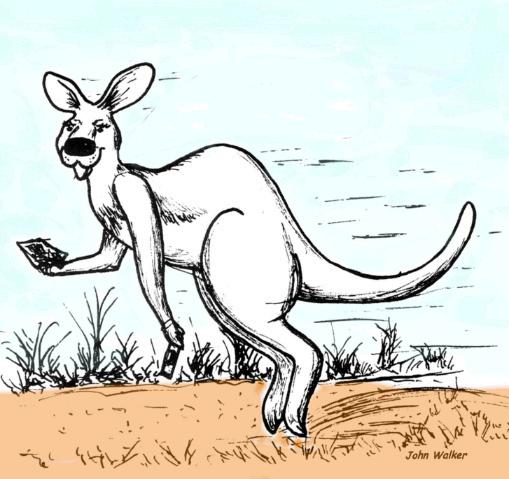
AOC Australian Orienteering Championships
ASC Australian Sports Commission
ASOC Australian Schools Orienteering Championships
DNF / DNS Did Not Finish / Did Not Start
EOC European Orienteering Championships
EOD Enter On the Day
EYOC European Youth Orienteering Championships
IOF International Orienteering Federation
JWMTBOC Junior World Mountain Bike Orienteering Championships
JWOC Junior World Orienteering Championships
KO Knock Out
MTBO Mountain Bike Orienteering
NOL National Orienteering League
OA Orienteering Australia
ONZ Orienteering New Zealand
WMTBOC World Mountain Bike Orienteering Championships
WOC World Orienteering Championships
WRE World Ranking Event




VICTORINOX AWARD
This issue’s Victorinox Award goes to Jenny Komyshan for her assistance in distributing the magazine in Western Australia.
Jenny will receive a Victorinox Handyman which includes 24tools and features – retail value $139.
46 THE AUSTRALIAN ORIENTEER JUNE 2024
OF THE ORIGINAL SWISS ARMY KNIFE | ESTABLISHED 1884 ICDT answers
the difference answers
1. E; 2. E: 3. C. O-SPY
MAKERS
Spot
Quiz answers:
Top Events



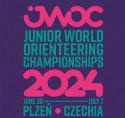




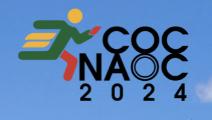
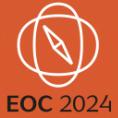




29 May2 June
June 1-2
MTBO World Cup Rd 1 & European Elite, Junior & Youth MTBO Championships Ostróda, Poland
World Cup Round 2 Genova, Italy
June 15-16 Jukola Relays Lakia, Finland
June 21-24 European Youth Orienteering Championships 2024, Szczecin, Poland
June 30July 7 JWOC 2024 Pilsen, Czechia
July 12-16 Sprint WOC 2024 Edinburgh, Scotland
July 21-27 O-Ringen 2024 Smålandskusten, Sweden
August 1-5 World University Orienteering Championships 2024 Bansko, Bulgaria
August 3-9 World Masters Orienteering Championships Turku, Finland
August 5-10
WMMTBOC 2024 Viborg, Denmark
August 6-11 North American Orienteering Championships Ottawa, Canada
August 16-20 World Cup Round 3 and EOC 2024, Mór, Hungary
Sept 9-15 WMTBOC & JWMTBOC Bulgaria
Sept 27-29 World Cup Final, Kuopio, Finland
Sept 28 - Oct 6 AUS Champs Carnival Armidale, NSW
Oct 12-19 Alice Springs Masters Games
Oct 18-20 AUS MTBO Championships, ACT
Nov 21-24 3 Days Orienteering Mauritius
Dec 20-26 Asian Orienteering Championships Chiang Mai, Thailand
Dec 27-31 Xmas 5 Days, Sydney, NSW

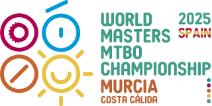
April 18-21 AUS 3 Days Carnival
April 28-May 4
May 17-30
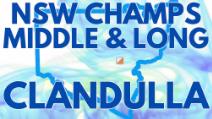
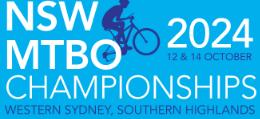


Loddon Shire, Victoria
WMMTBOC 2025
Murcia, Costa Calida, Spain
World Masters Games 2025
Taipei, Taiwan
June 19-22 Orienteering World Cup Round 1 Sweden
June 28 - July 4 JWOC 2025
Bormio, Italy
July 7-12 Forest WOC 2025 Kuopio, Finland
July 17-20 European Youth Orienteering Championships Czechia
Aug 7-13 The World Games 2025, China
Aug 8-15 WMOC 2025 Girona, Spain
Aug 11-17 (prelim dates) WMTBOC & JWMTBOC 2025 Poland
Aug 26-31 EOC 2025 & World Cup Round 2 Antwerp, Belgium
Tbc AUS Champs Carnival, Queensland
July 4-11 JWOC 2026 Sweden
July 6-11 WOC 2026 Italy
Aug 7-14 WMOC 2026 Poland
Sep 27 - Oct 4 Oceania Championships
JUNE 2024 THE AUSTRALIAN ORIENTEER 47 2025
2026
2024 – STATE CHAMPIONSHIPS AND CITY RACES Aug 10-11
Sep 22 WA O Championships Aug 11 ACT & NSW Ski-O Championships Aug 24-25 ACT O Championships Aug 24-25 Queensland MTBO Championships Aug 31-Sep 1 Victorian MTBO Championships Sep 7-8 NSW O Championships Sep 8 SA O Championships Sep 15 and 22 Victorian O Championships Sep 21-22 Queensland O Championships Oct 12 and 14 NSW MTBO Championships SW Sydney Oct 13 Sydney City Race Nov 17 Melbourne City Race 2024 2024
ACT
and


















aussieogear .com mobile: 0415 210 339 email: colinp53@yahoo.com.au www. aussieogear.com SUPPLIER OF: ORIFIX, VAVRY, SIVEN/BRYZOS, VAPRO, MOSCOMPASS AUSTRALIAN AGENT FOR SPORTIDENT & TRIMTEX • Pants • Shirts • Socks • Gaiters • Map Boards • Compasses • Spectacles • Flags • Punches SIAC SIAC training & school kits SIAC timing equipment CLUB UNIFORMS Club shirts, pants and jackets can be organised by Colin at Aussieogear. Colin will organise design, manufacture and delivery with all costs covered by one per item costing.

























































































































































































































































































































